1803
The Louisiana Purchase was the acquisition by the United States of approximately 530 million acres (828,000 sq mi or 2,100,000 km²) of French territory on April 30, 1803, at the cost of about 3¢ per acre (7¢ per ha); totaling $15 million or 80 million French francs. Including interest, America finally paid $23,213,568 for the Louisiana territory.[1] The land purchased contained all of present-day Arkansas, Missouri, Iowa, Oklahoma, Kansas, Nebraska, Minnesota south of Mississippi River, much of North Dakota, nearly all of South Dakota, northeastern New Mexico, northern Texas, the portions of Montana, Wyoming, and Colorado east of the Continental Divide, and Louisiana on both sides of the Mississippi River, including the city of New Orleans. (The Oklahoma Panhandle, and southwestern portions of Kansas and Louisiana were still claimed by Spain at the time of the Purchase.) In addition, the Purchase contained small portions of land that would eventually become part of the Canadian provinces of Alberta and Saskatchewan. The land included in the purchase comprises around 23% of the territory of the modern United States.[1] The purchase was an important moment in the presidency of Thomas Jefferson. At the time, it faced domestic opposition as being possibly unconstitutional. Although he felt that the Constitution did not contain any provisions for acquiring territory, Jefferson decided to purchase Louisiana because he felt uneasy about France and Spain having the power to block American traders' access to the port of New Orleans.
1807
Valentine Dorsette Richard settle on the Biloxi peninsula.(American State Papers Vol. 3, p. 38)
1810
The Republic of West Florida was declared independent of Spain in September at St. Francisville, Louisiana. It lasted only forty-five days.
1811
When Dr. William 'Fat Doctor' Flood, the representative of Governor Claiborne of the Orleans Territory, was dispatched to the Mississippi coast to hoist the flag of the United States in January 1811, he found the population between the Pearl River and Biloxi to be about four hundred people chiefly French and Creoles. Dr. Flood in his report to Governor Claiborne wrote: proceeded to the Bay of Biloxi, where I found Mr. Ladnier (Jacques), and gave him the commission (Justice of the Peace). He is a man of excellent sense, but can neither read or write, nor can any inhabitants of the bay of Biloxi that I can hear of. They are, all along this beautiful coast, a primitive people, of mixed origin, retaining the gaiety and politeness of the French, blended with the abstemiousness and indolence of the Indian. They plant a little rice, and a few roots and vegetables, but depend on subsistence chiefly on game and fish. I left with all these appointees copies of the laws, ordinances, etc. But few laws will be wanted here. The people are universally honest. There are no crimes. The father of the family or the oldest inhabitant, settles all disputes......A more innocent and inoffensive people may not be found. They seem to desire only the simple necessities of life, and to be let alone in their tranquility. I am greatly impressed with the beauty and value of this coast. The high sandy lands, heavily timbered with pine, and the lovely bays and rivers, from Pearl River to Mobile will furnish New Orleans with a rich commerce, and with a delightful summer resort. For a cantonment or military post, in consideration of the health of the troops, this whole coast is admirably fitted.
1812
Jackson County was created on December 12, 1812 as part of the Mississippi Territory.
1817
Mississippi entered the Union on December 10th as the 20th State of the United States of America.
1821
September 1821 Hurricane
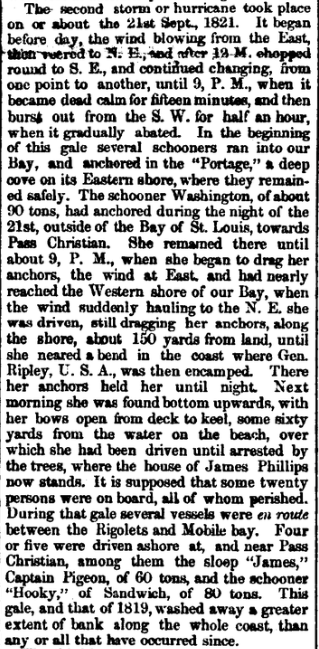
[The Daily Mississipian [Jackson], October 5, 1859, p. 2]
1823
Cady [Cadet?] Lafontaine - Died, a few days past, at the Bay of Biluxi [sic], in the State of Mississippi, Cady Lafontaine, at the remarkable age of 137 years. He retained his faculties until the day of his death.[The Louisiana State Gazette, New Orleans, December 18, 1823]
1832
Traveling from Mobile to New Orleans Jun 30, 1832
Farmer’s Cabinet newspaper, Amherst, New Hampshire
"Descriptions of Scenery in the West, from the Correspondent of the Young Men’s Advocate"
New Orleans, May 1832. – Messrs Editors –
On the morning of the 11th, I left Mobile for this place. Our road lay through the pine woods to Pascagoula, and thence through Lakes Borgne and Pontchartrain. This is the great mail route to New Orleans. The mail is carried through daily, at an annual expense of thirty-seven thousand dollars. The distance is about one hundred and sixty or seventy miles. The first six or seven miles of the road is pleasant. After leaving Spring Hill, we entered the pine woods, and left behind us all traces of civilization. There are only four or five log cabins in a distance of forty miles. For the first fifteen or twenty miles, the road appears to have never been worked. The woods are open, and wherever the road is too much cut up, or where it becomes gullied by the rain, it is only necessary to strike a new path. Sometimes a man is sent out with an axe to select the most level course, and to blaze the trees between which the future road is to pass. There is little soil; there is, however, sufficient grass and weeds growing to hide the road. No underbrush hides the view, neither is it obstructed by the branches of the pines. As you ride along, you may see far into the woods on either side. There is a beauty and wildness in the prospect which is at first enchanting; but it becomes somewhat tedious, as you see only a succession of the same objects.
It was a mild clear morning when we entered the forest. The straggling rays of the sun, which had penetrated the matted covering above, were shining here and there, contrasting finely with the dark surrounding shades. These lights and shades were continually varying as we whirled rapidly along. The driver several times, for our gratification, would sound his hunter’s horn, which was echoed far and wide. After having passed over about twenty miles, we came to what are termed by the Spaniards, lagunes. These are low marshy spots, and sometimes valleys with running streams, the former covered, and the latter skirted, with a thick growth of underwood, which is almost impenetrable. It consists of low soft maple, and of a shrub which resembles our hazel bushes, called, in the language of this country, tight eye. (Think it must have been the titi shrub.) It is at least well named, for, to use a homely and common expression, you may as well look into a mill-stone as look into one of these lagunes. The deer, which abound, run into them to hide themselves, and to escape their pursuers. I did not see any, though I was told that frequently herds of them were seen bounding across the road at other times. There are in this part of the route some inconsiderable prairies, which are covered with a fine growth of grass, and which have a vegetable mold of six or eight inches in depth. They might be cultivated to some advantage, but the land is so much more fertile up the country, which can be purchased of government at the same prices, that few persons are disposed to settle upon this.
The pine tract runs thirty or forty miles into the interior, and extends along a greater part of the northern shore of the Gulf of Mexico. The few persons who live upon it subsist chiefly by raising cattle and hogs. We saw a small herd of cattle feeding upon the prairies.
The planters in the interior of Alabama and Mississippi raise large numbers of cattle. One of them told me that the had several thousand of them ranging through the forest. They cost nothing except a few days’ labor, once or twice a year, in collecting them together. These are exciting periods. Several planters unite, and with their slaves construct a large pen. They then separate, and drive indiscriminately into it all the cattle which they can find. They are mounted upon small, tho’ fleet Indian ponies, and can ride through the open woods with great speed. In their hands they carry the cow whip, which is composed of a short stalk, eighteen or twenty inches in length, and a lash as many feet long, terminated with a strip of half tanned deer skin. Those who are skilled in its use throw it forward and with great precision and force, and with a noise as loud as the report of a rifle. The gentlemen who I mentioned above, said that sometimes spent several days in the woods, and encamped at night, when engaged in gathering his cattle.
Our friend R., left Mobile a few days after our arrival there, and had been spending his time at one of the log cabins in the woods, and at Pascagoula. A residence in the pine woods is considered healthy in the summer, and they are resorted to by those who live in the cities and towns, and on the low grounds. The air is dry and pure, and a journey to the north is saved. This section of pine woods about Pascagoula is becoming a place of resort for the citizens of New Orleans. The Rev. Mr. Flint, who has written a sketch of the valley of the Mississippi, thus closes one of his poetic effusions on leaving the pine woods. They had formed a little settlement, which was nightly illuminated by the blazing torches of the pitch pine. They hunted in the wood and fished in the streams.
Pascagoula is a small place upon the banks of the bay of the same name. The settlement consists of less than a dozen houses. These are small and neat. Here the steamboat comes up which runs across the lakes (Mississipppi Sound). We went on board about dark, and the next morning found ourselves near the farther shore of Lake Bourn (Borgne). The land, in the immediate vicinity of these lakes, is low and marshy, and covered with tall rank grass. Here and there are seen little rises of ground, with clumps of trees covered with a rich and beautiful foliage. Farther back from the shore the land is somewhat higher, and is inhabited, and is said to be well timbered. We had a flotilla upon Lake Bourn in the last war, which was captured by the British after a gallant defense. Lakes Bourn and Pontchartrain are united by what the French call the Rigolet, which is a narrow, deep steam or channel, extending from one lake to the other, a distance of three or four miles. At the farther extremity of the rigolet, near Lake Pontchartrain, is situated Fort Pike. It occupies a small elevation, and is a neat, respectable fortification, garrisoned with a hundred and fifty or two hundred men. It was a fine clear morning when we entered the rigolet, and the brown walls and white sentry boxes of Fort Pike rose beautifully into view.
We soon saw into Lake Pontchartrain, and about ten o’clock arrived at the termination of the rail road which runs to New Orleans, four miles distant. It runs almost the whole distance through a swamp covered with large cypress. This rail road comes into the lower part of the city. Farther up, and parallel with it, runs the Marigny Canal, which leaves the lake at the bay on St. John, and terminates in a basin in the suburbs of the city. Still farther up is the new canal of the New Orleans Banking and Canal Company, which is not completed, and which will cost not far from half a million dollars. The trade of the lakes must be very considerable to warrant the construction of all these works. An important trade is carried on through the lakes with Mobile, Pascagoula, Mandeville, Pensacola and Apalachicola. The northern shores of the lakes will also furnish fuel and timber for the city. This trade now employs between three and four hundred vessels of the smaller size. In my next I will endeavor to give to you a view of New Orleans.
1837
The Picayune began publishing it newspaper at 38 Gravier Street at NOLA on January 25, 1837 by Francis A. Lumsden and George Wilkins Kendall (1809-1867). The four page journal cost 25 cents per week or 6 1/4 cents per issue, the value of a Spanish picayune. A three months subscription was $2.50. By early November 1837, the paper became The Daily Picayune. In 1914, The Daily Picayune merged with The New Orleans Times-Democrat to become The Times-Picayune.
The Alert, a steam packet based in NOLA, was stopping at Biloxi as early as July 1837.(The Picayune July 23, 1837, p. 3)
The Diocese of Natchez was established by the Roman Catholic Church on July 28, 1837.(The Mississippi Register, August 3, 1962)
1838
In July, politicians at NOLA who overheated in the recent elections were advised to relax and enjoy a sojourn to Pass Christian or Biloxi on the Isabella.(The Daily Picayune, July 4, 1838, p. 2)
The Rene' Lameuse [1788-1883] hotel [probably the Shady Grove] at Biloxi
[The Courier [NOLA], July 23, 1838, p.3]
The above advertisement in French appeared in the captioned New Orleans journal in July 1838 and can be translated as follows:
Public House at Biloxi
The undersigned has opened a home for the reception of those people who want to spend some time in Biloxi. It is never neglected to render his relaxation in a nicer place on the Lake. Entertaining games and other amusements are available for people who want to visit the hotel; all is available for their convenience. For this reason, the undersigned recommends the beautiful new house of [Rene] Lameuse. The price will be very reasonable.
6 July F. Fizane
1839
Earnest H. Ogden, Esquire, member of the Natchez bar died of Yellow Fever on the 7th of October at Biloxi. He had been to Mobile on a pleasure excursion and caught fever. Mr. Ogden was a native of New Jersey.(The Newark Daily Advertiser, October 15, 1839)
1840

[The Macon Intelligencer, March 21, 1840, p. 2.]
A German at Biloxi cut his throat with a razor on Sunday morning severing the wind pipe. No physician being immediately at hand the wound was sewed up by a gentleman entirely unaquainted with surgery and it is thought that it will not prove fatal. The cause of the intended suicide is said to be Love.(The Daily Picayune, August 25, 1840, p. 2)
1841
Harrison County, Mississippi was formed from Hancock and Jackson County, Mississippi on February 5, 1841.
Mississippi City was established on July 21, 1841, as the Harrison County seat of government. Biloxi's first voting precinct was in the home of Jacob Elmer. [Minutes Harrison County Board of Police 1, July 27, 1841, p. 5]
Rene Lameuse was the first Supervisor of Beat 1 representing Biloxi. Lameuse promoted a night patrol at Biloxi which became effective on August 1, 1841. The night patrol was headed by Peter Flanagan and his local recruits. The night patrol was committed to preserve the peace in the village of Biloxi and to arrest free negroes and slaves that violated the 9 p.m. curfew, unless they had written permission from their master, mistress or overseer. The curfew violators were to be punished as directed by the law. [Minutes Harrison County Board of Police Book 1, July 27, 1841, p. 5]
1842
The road from Pt. Caddy to Henderson Pt. on the Bay of St. Louis was declared a Public Road. Charles Bellman was appointed overseer of this road from Pt. Caddy to the west line of the 1st Police [Beat] District.[Minutes Harrison County Board of Police, Book 1, March 14, 1842, p. 18]
Benjamin Holley appointed Captain of the police patrol at Biloxi.[Minutes Harrison County Board of Police, July 4, 1842, p. 26]
1843
The American Hotel was in operation by Edward Milford of Mobile at Biloxi near Elmore's Wharf (probably Jacob Elmer's). It was two-story edifice with a dining hall, superior cook, and good wines.(The Daily Picayune, June 9, 1843, p. 1)
In August 1843, Annette 'Manette' Fayard Leader (1791-1853) sold for $200 a lot on Pass Christian Road [1/2 acre, east and west] and 150 feet deep to the Catholic Diocese of Natchez, which would become the site of the Nativity B.V.M. Catholic Church.(Harrison Co., Ms. Land Deed Bk. 1, p. 355)
1845
Batchelor's Hall, a tourist residence, J.B. Currie, proprietor, had a ten-pin alley attached to the building.(The Daily Picayune, July 2, 1845, p. 4)
1846
1847
John Hahn (1806-1847), proprietor of the Magnolia Hotel died.
On June 22nd, John Fayard sold the Federal Government a tract of land at Biloxi to build a lighthouse. The consideration was $600.(Harrison Co., Ms. Land Deed Bk. 3, p. 392)
1848
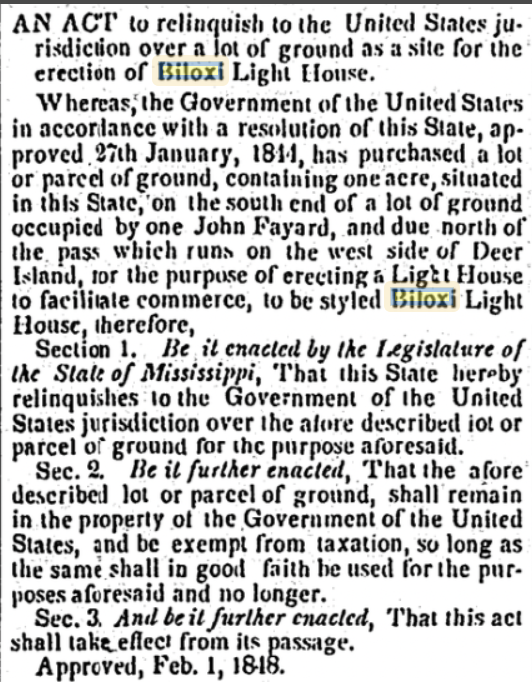
[The Mississippian [Jackson], February 28, 1848, p. 5]

[The Charleston [SC] Courier, August 3, 1848, p. 2]
John W. Nixon (1782?-1849), Irish immigrant and veteran of the War of 1812, was operating the Biloxi House, a tourist home or inn, on East Beach west of Bellman Street.(The Daily Picayune, September 7, 1848, p. 1)
1849
John McGuire who lived and operated a grist mill on the north side of the Pass Christian Road-Point Caddy Road [Howard Avenue] west of Lameuse Street died. Mary McGuire, his widow, petitioned the Harrison County Chancery Court to sell their Biloxi property and was granted her wish in April 1849.(Harrison Co., Mississippi Chancery Court Minute Bk. 1, p. 179)
Madame Pradat's Live Oak Hotel was operating on Biloxi's East Beach road.
John W. Nixon (1782?-1849) died at Biloxi on June 17th.
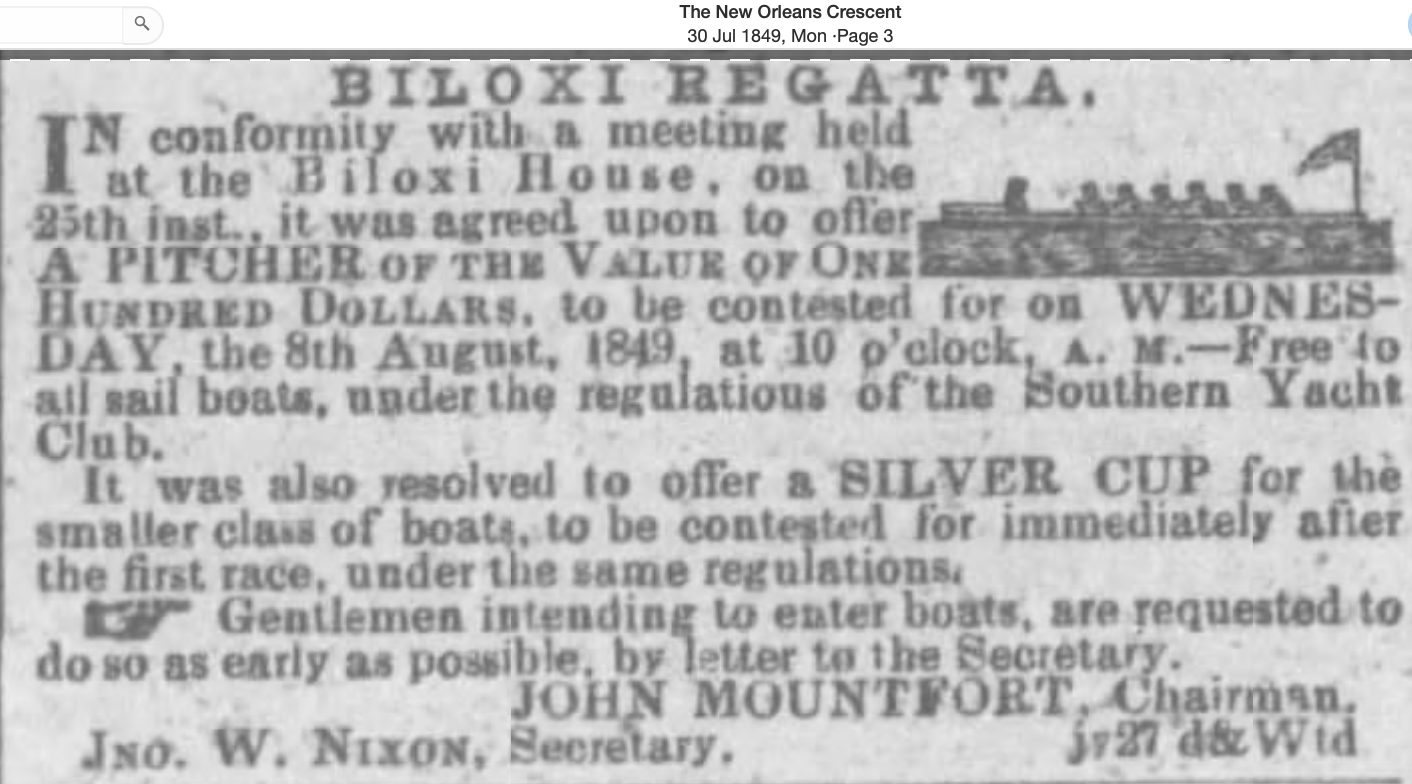
1850
Biloxi was incorporated on February 18, 1850.
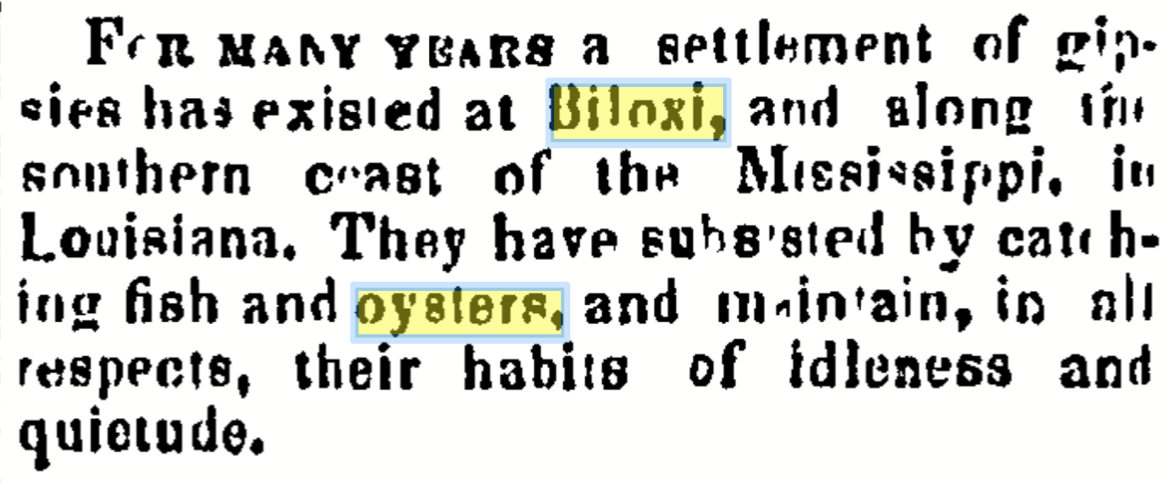
[The Trenton [NJ] State Gazette, February 21, 1850, p. 2]
Biloxi had at least four hotels operating in the summer of 1850: The Shady Grove, proprietor John Coates; The Green Oaks of Madame Pradat; The Biloxi House operated by Adeline Copp Nixon and The Magnolia Hotel leased to Mrs. C.M. Hunt.(The Daily Picayune, June 8, 1850, p. 8 and August 1, 1850, p. 8)
1851
First America's Cup race sailed at the Isle of Wight on August 22nd.
The Daily Picayune reminded readers that it was cheaper to vacation at Pass Christian, Biloxi, Pascagoula, Mobile Bay, and Point Clear and other nearby resorts rather than traveling North. The following inns were available: the Pass Christian Hotel by Montogomery, at Pass Christian; Biloxi House by Nixon, Biloxi; Green Oaks Hotel, by Mrs. Pradat, Biloxi; Magnolia Hotel by Mrs.Hunt, Biloxi; Shady Grove by Coates, Biloxi; East Pascagoula Hotel by Boyd & Simpson; Point Clear Hotel, Baldwin County, Alabama; Daphne House, eastern shore of Mobile Bay; and also Cooper's Well in Mississippi.(The Daily Picayune, May 27, 1851, p. 2)
1852
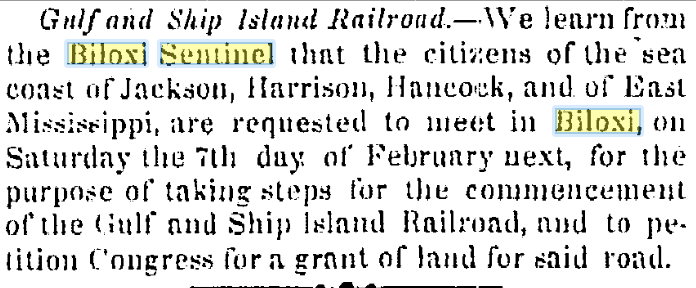
[The Daily Picayune, February 4, 1852, p. 2]
Twenty tracts of land each having one arpent on the Gulf and being between 12 or 15 arpents deep were for sale at Biloxi.(The Daily Alabama Journal, April 26, 1852, p. 2)
Captain Fry of the steamboat, D.J. Day, will make regular semi-monthly trips between Wetumpka, Alabama and New Orleans with stops at Pascagoula, Biloxi, Pass Christian and Bay St. Louis.(The Daily Alabama Journal, May 28, 1852, p. 2)
Benjamin L.C. Wailes (1797-1852), State Geologist of Mississippi, viewed the village of Back Bay, present day D'Iberville, from Biloxi on August 27, 1852, and observed the following: Rode in the morning, after a call from Judge Smith, to Back Bay 2 miles, which is the extension of the Bay of Baluxi (sic). Found a steam ferry running across where it seems to be a mile in width. The extensive brick yard of Mr. Kendall, where bricks are made on a very extensive scale from dry compressed earth by steam power, was in sight of the opposite side, about two miles distant. A number of small craft were in the Bay, and several along the shore were undergoing repairs. Several steam mills, which are very numerous on the Bay, for sawing pine timber, were also in view.(Wailes, 1854)
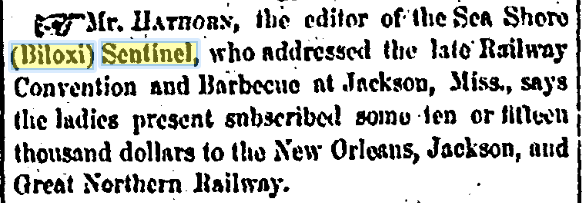
[The Cincinnati Daily Gazette, September 2, 1852, p. 2.
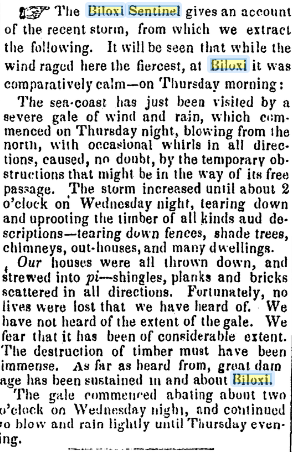
[The Alabama Planter, September 4, 1852, p. 6]
1853
Batchelor's Hall, an inn, run by Sol Mills (b. 1818) was operating, at Biloxi.(The Daily Picayune, June 9, 1843, p. 1)
Yellow Fever struck Biloxi on June 29th, when it was brought to Biloxi by someone from New Orleans. Dr. Andreas Byrenheidt (1768-1858) reported following the crisis that there were 533 cases of Yellow Fever in Biloxi, which resulted in 111 deaths. He estimated that the population at this time was 5500 people, which included summer tourists and those fleeing the epidemic at New Orleans.(Testimony of Dr. A. Byrenheidt, M.D. in Report of the Sanitary Commission of NOLA on the Yellow Fever of 1853, 1854, p. 540)
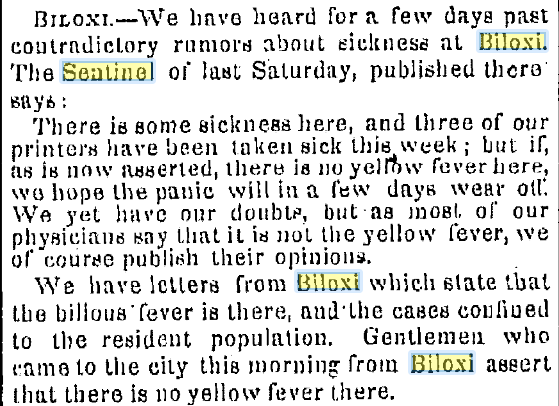
[The Daily Picayune, August 23, 1853, p. 1]
The 1853 Yellow Fever epidemic at New Orleans killed about 10,000 of the 30,000 persons infected with the mosquito borne virus. It earned the Crescent City the epithet "Necropolis of the South".
In September, Frederick A. Renoir sold for $50 to the Congregation of the Hebrew Society of NOLA a tract of land on the west side of Reynoir Street. It was to be used as a Jewish Cemetery. Trustees for the Jewish Cemetery were: Leopold Klopman (1810-1873) and Adolph S. Marks (1791-1867) of New Orleans and Samuel Friedlander (1813-1886) of Biloxi.(Harrison Co. Mississippi Land Deed Bk. 6, p. 518)
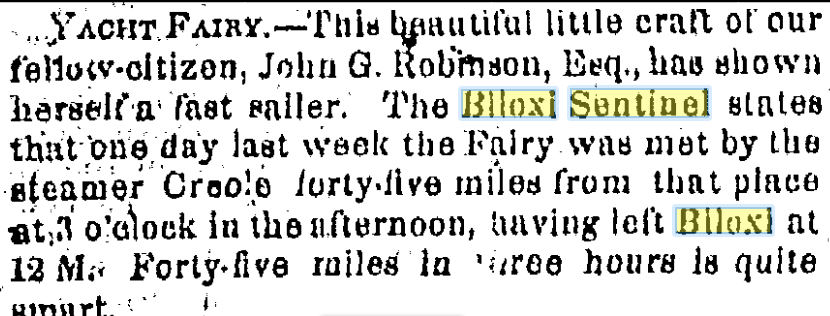
[The Daily Picayune, October 11, 1853, p. 2]
1855
Mrs. Adeline Copp Nixon (1798-1878) gave John Moore of NOLA a one year lease for $200 on the east end of Batchelor's Hall , a long building attached to the Biloxi Hotel. Mr. Moore had use of the billiard table and liquors in the bar and all the furniture.(Harrison Co. Mississippi Land Deed Bk. 7, p. 496)
The Hurricane of 1855 of September 15th-16th hit near Bay St. Louis, and destroyed bath houses, piers and many houses at Biloxi between its three miles of waterfront development from west of the Biloxi Lighthouse to Point Cadet.(The New Orleans Daily Picayune, September 20, 1855, p. 1 and Sullivan, p. 135)
1856
The Last Islands [Isles Dernieres] Hurricane mauls this seaside resort off of Terrebonne Parish, Louisiana on August 11th and kills about 200 people. According to modern estimates by the NOAA the storm was probably a Category 4 hurricane with central pressure of around 934 mb. It tied with Hurricane Hugo as the 10th most intense hurricane to hit the mainland United States.
1857
Pierre Pascal Hugonin (1801-1857), native of France and Justice of the Peace at Biloxi, died on September 7, 1857. He was replaced by William H. Norberg (1829-1860+), native of Massachusetts.
1858
Dr. Andreas Byrenheidt (1786-1858), Biloxi physician and native of France, expired on March 4th.
T.H. Jenks, late of the East Pascagoula Hotel, and N.B. Cook, recently of the Biloxi House, have leased the Live Oak Hotel, formerly Nixon's Hotel.(The Daily Picayune, September 10, 1858, p. 3)
1859
In 1859, Joseph H. Bellande (1813-1907) sold to Bishop William H. Elder of the Diocese of Natchez a lot measuring 192 x 100 feet for the first site of St. Alphonsus Catholic Church in Ocean Springs on Porter Avenue for $100.
John Lynch, proprietor of the Woodbine Cottage, had space for $25.00 month-children and servants half price-table furnished with best that NOLA and Biloxi markets can provide.(The Daily Picayune, September 10, 1859, p. 3)
1860
A reporter for the NOLA Daily Crescent aboard the steamer, Alabama, related that the wharves at it’s regular stops along the entire Mississippi coast had been destroyed by the storm of September 15, 1860. At Biloxi, a popular citizen shared the following: The gale yesterday was more severe than that of 1819; severe damages and real estate losses were estimated as follows: Jacob Elmer, $12,000; John Brown, $7,000; Jacob Wetzel, $5000; Rene’ Lameuse, $2,000; Gabriel Marzeau, $2000; A. Bernard, (Henley), $10,000; S. Frilonder [sic]; Mrs. Hohn [sic], $1,000; Mr. Garonza, $2000; Sol. Mills, $2000; John Colley, $2000; Mrs. Holley, $500; and Mrs. A.C. Nixon, $500. Estimates of total losses at Biloxi were placed at no less than $30,000. No moorings remained and the shore was a collage of ruins: homes, stores, driftwood and dry goods.[The New Orleans Daily Crescent, September 18, 1860, p. 2]
John B. Toulme (1795-1860), native of Saint Domingue, now Haiti, expired at Bay St. Louis, on August 17th. He was a pioneer settler of this village and assisted General Andrew Jackson (1767-1845) with information on the British invasion forces in this area during the War of 1812.(The Daily Picayune, August 25, 1860, p. 2)
1861
The War of the Rebellion or American Civil War commences on April 12, 1861 in South Carolina.
“The Biloxi Rifles”, Company E, 3rd Mississippi Infantry Regiment, C.S.A., were sworn into State military service on May 21, 1861 and mustered in Confederate service on October 5, 1861.(Howell, To Live and Die in Dixie, 1991, p. 565)
1862
'The Capture of Biloxi during the War Between the States'-published October 10, 1885 and written by Major W.T. Walthall.[see reprint in The Daily Herald, June 4, 1941, p. 5]
1865
The Civil War ends on April 9, 1865 in Virginia.
1866
U. Cousine of Biloxi won a silver medal at the Lousiana State Fair for the best display of lemons.(The Daily Picayune, November 25, 1866, p. 2)
1870
Captain Charles N. Walker (1821-1870), age 49 years and steamboat captain who worked between NOLA and Mobile, died at Ocean Springs on January 15, 1870.(The New Orleans Times, January 18,1870, p.6)
On October 29, 1870, the New Orleans, Mobile, & Chattanooga Railroad (Chartered 1866) completed the rail line between Mobile and New Orleans. Rail service commenced on November 21, 1870.
1871
The N.O.M. & C. was reorganized on April 18, 1871 and became the New Orleans, Mobile & Texas Railroad.
1873
The New Orleans, Mobile & Texas Railroad was foreclosed upon in the U.S. Circuit Court [Henry J. Gardner and Peter B. Butler v. N.O.M. & T.] for default of payment of interest on its $4 million in indebtedness to its bondholders. The road missed interest payments due in October 1872 and April 1873. It was ordered sold at auction in six months.(The New York Times, April 15, 1873, p. 1)
1874
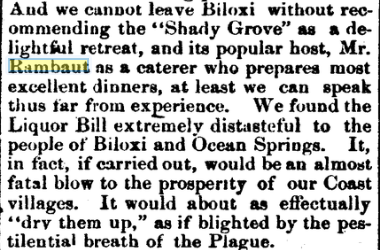
[The Weekly Clarion [Jackson, Mississippi], July 16, 1874, p. 1]
Joseph Santini (1817-1874), native of Trieste, Italy, expired on August 11, 1874 at St. Christian, Basse Pyrenees, France. His corporal remians were interred in the St. Louis Cemetery No. 3 at NOLA in October 1874.(The Daily Picayune, August 12, 1874, p. 4 and October 17, 1874, p. 4)

[The NOLA Bulletin, November 27, 1874, p. 6]
1875
On January 13th, Arthur Reynoir and spouse sold Mother Mary Austin Carrole representing St. Alphonsus Convent of Mercy for $1000, a lot on the west side of Reynoir Street with buildings and improvements. The lot had 200 feet on Reynoir Street and was 85 feet deep.(Harrison Co., Mississippi Land Deed Bk. 14, p. 320)
An editorial in The Star of Pascagoula blasted the New Orleans, Mobile & Texas Railroad as "nothing more that or less than a gang of highway robbers, entitled to as little consideration from the people as so many bandits who rob and plunder the weak and defenseless in defiance of the law. The only remedy for these wrongs is the sale of the road. Refuse to patronize the road, even if undergo inconvenience in doing so."(The Star of Pascagoula, May 22, 1875, p. 2)
In June, D.B. Seal, District Attorney of Hancock County filed litigation against the New Orleans, Mobile, & Chattanooga Railroad (sic?). The plaintiffs were asking that the railroad build a draw bridge across the Pearl River. The present bridge was blocking the East Pearl River channel, which was needed for the lumber trade.(The Star of Pascagoula, June 12, 1875, p. 3)
Peter J. Montross (1841-1897), native of Cuba, was the proprietor of the Bossell House.(The Daily Picayune, June 13, 1875, p. )
In the summer of 1875, the Shady Grove Hotel was managed by Urbain Rambaut (1832-1889), a native of France. The hostelry was in the process of renovation and refurbishment. Professor Knapp, a local guide with a horse and buggy, was available for fishing in Back Bay or leading local history tours.(The Star of Pascagoula, June 26, 1875, p. 1.)
1876
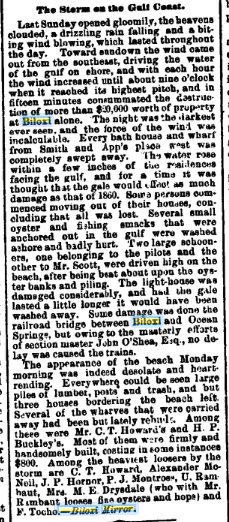
[The New Orleans Republican, March 26, 1876, p. 6]
1877
The 1st Baptist Church of Biloxi [Colored] began in 1877. The Reverend Pleasant Gill, an ante-bellum preacher, held their first church service in an old shack near the L&N Railroad depot.(The Daily Herald, April 22, 1940, p. 5)
Captain T. Frederick Nehls (1811-1877), Prussian immigrant mariner and mail carrier, expired on March 7, 1877.
On April 1st, the New Orleans, Mobile & Texas Railroad almost doubled it fare to $.05 per mile. Before the passenger rate increase the cost of a round trip ticket to New Orleans from Pascagoula was $5 and to Mobile $2. After increase, the New Orleans fare was $10 and that to Mobile $4.10.(The Star of Pascagoula, April 6, 1877, p. 1)
1878
John Brill (1802-1878), native of Philadelphia, Pennsylvanisa and first Sheriff of Harrison County, Mississippi expired on June 24th at Pass Christian. Mr. Brill was active in creating Harrison County from Hancock County and served th enew county in various political offices.(The Pascagoula Democrat-Star, June 28, 1878, p. 3)
W.K.M. Dukate of Wheatland, Indiana married Linda Lienhard of Biloxi on April 27th in Biloxi.(The Pascagoula Democrat-Star, May 3, 1878, p. 3)
Adeline Copp Nixon (1798-1878), native of Dover, New Hampshire, retired Biloxi hotel proprietor and widow of John W. Nixon (1782?-1849), Irish immigrant and NOLA attorney, died on June 28th.(The Pascagoula Democrat-Star, July 7,1878, p. 3)
James Fewell (1808-1878) native of Virginia and Postmaster at Biloxi from October 1852 until December 1853 expired on December 13, 1878. Dr. Theruber of new Orleans acquired the Fewell place on Back Bay in October 1880.(The Pascagoula Democrat-Star, December 13,1878, p. 2 and October 22, 1880, p. 3)
1879
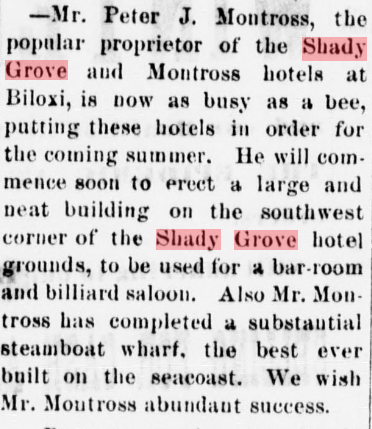
(The Pascagoula Democrat-Star, February 7, 1879, p. 3)
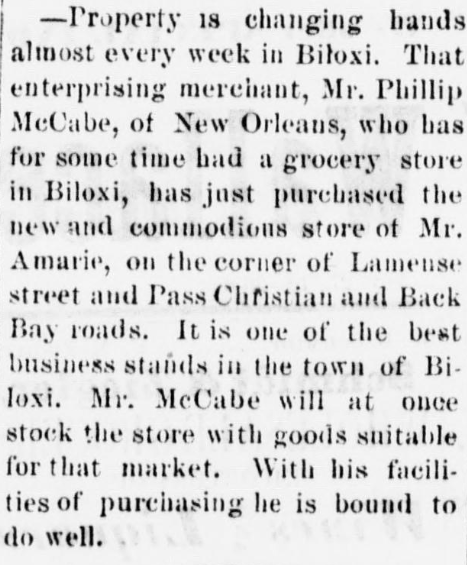
(The Pascagoula Democrat-Star, February 7, 1879, p. 3)
Jefferson Davis (1808-1889) acquired the orange orchard of Mrs. S.A. Dorsey at Beauvoir for $5000.(The Pascagoula Democrat-Star, February 28, 1879)
The new railroad bridge will soon be finished.(The Pascagoula Democrat-Star, September 12, 1879)
Professor D.D. Cowan opened the Public School on 1 September.(The Pascagoula Democrat-Star, September 12, 1879)
1880
In January, the residence of Dr. J.Y. Hollingsworth, near Beauvoir, was destoyed by fire. The fire began when a spark from the chimney fell on the roof. Shortly the house and kitchen were burning. Dr. Hollingswoth salvaged very little of his domiciles contents.(The Pascagoula-Democrat Star, January 30, 1880, p. 3)
On Saturday, January 3rd, there was launched at Point Caddie a fine schooner, built by Marsh Ridgeway for Messrs. Lopez & Co., and is intended to be used in the oyster business. She is a fine craft, and the builder deserves credit for the workmanship manner in which the craft is built. Wine flowed freely and the launch will long be remembered.(The Pascagoula-Democrat-Star, "Biloxi Items", January 30, 1880, p. 3)
Biloxi was nearly deserted on Mardi Gras day. The Camelia carried nearly seventy-five passengers to NOLA.(The Pascagoula Democrat-Star, February 20, 1880, p. 3)
Federal employees were removing the Biloxi Lighthouse dwelling because of its dilapidated condition. It will be placed by a neat residence.(The Pascagoula Democrat-Star, March 5, 1880, p. 3)
F.W. Elmer is building a structure on the beach in front of his saloon. It is intended for a restaurant.(The Pascagoula Democrat-Star, March 26, 1880, p. 3)
Biloxi's streets have been throughly repaired, a shell road has been built along the beach, the facilities to procure, fish, oysters and meat are ample, and in fact almost anything that may be desired can be procured at moderate rates.(The Pascagoula Democrat-Star, March 26, 1880, p. 3)
A duel was fought near Biloxi between Captain Cain and Captain Sambola of New Orleans. Colt pistols were used, but after an exchange of gunfire with no one hit, the friends of the combatants succeeded in finding an amicable settle- ment and the dispute ended with a reconciliation between the warring parties.(The Pascagoula Democrat-Star, April 9, 1880, p. 3)
The L&N Railroad leased the property of the N.O.M. & T. Railroad on May 8, 1880.
Messrs. Lopez & Co. have their new schooner, the Castelaro, employed in bringing oysters from outside and planting them on their bedding grounds. These gentlemen intend to keep well supplied with oysters, and be ready to meet the demand when the trade opens again.[The Pascagoula Democrat-Star, 'Biloxi Items' May 21, 1880, p. 3]
In May 1880, Theodore M. Scheffer (1849-1884), a Prussian immigrant, opened his establishment, the Scheffer House, for guests. It had been placed in first class condition for the season.(1880 Harrison Co., Mississippi Federal Census T9_648, p. 9, ED 139 and The Pascagoula Democrat-Star, May 28, 1880, p. 3)
Margaret Henley (1813-1880), wife of John Henley Sr. died on August 1st.(The Pascagoula Democrat-Star, August 20, 1880, p. 2)
1881
In April 1881, Father Francis Janssens (1843-1897), Dutch born missionary Catholic priest, was appointed the fourth Bishop of the Diocese of Natchez.
William Gorenflo, James Mayfield, and J.D. Mayer were appointed by the Board of Supervisors to form a committee to draft an ordinance to regulate the harvesting and cultivating of oysters in Harrison County, Mississippi.(The Pascagoula Democrat-Star, May 20, 1881, p. 3)
On October 5, 1881, the L&N Railroad purchased all the assets of the reorganized New Orleans, Mobile, & Texas Railroad for $6,000,000. This acquisition included the Ponchartrain Railroad which ran seven mile from New Orleans to Milneburg on Lake Ponchartrain, and the one hundred forty-one miles of track, depots, the creosote plant at West Pascagoula (Gautier), stations, station houses, section houses, rolling stock, etc. between Mobile and New Orleans. (JXCO, Ms. Land Deed Bk. 5, p. 299)
1883
City of Biloxi organized its fire company on September 3rd at the Montross Hotel. F.W. Elmer, pres.; Will C. Grant, v. pres.; P.J. Montross, treas.; Phil McCabe, foreman; Thomas P. Bachino, 1st assist.; and Frank Greveniing, 2nd assist. Others involved: Leon Bertoli; Joe Tucei; John B. Bachino; N. Petrie; Albert Deck; Thomas McCabe; Daniel Bachino; J.M. Ritch; M.J. Grady; George H. Schrieber and N. Sullivan.(The Daily Picayune, September 6, 1883, p. 1)
Raymond Caillavet (1838-1898), Commissioner of Streets, started a work gang to open a road from Porter west to the city limits to connect with the Beach Road to Mississippi City.(The Pascagoula Democrat-Star, October 5, 1883, p. 3)
1884
The Gulf Coast Advertiser reports that Biloxi appears to be the favorite place for Louisiana politicians.(The Daily Picayune, September 6, 1884, p. 2)
George Washington Wilkes (1854-1915) and M.B. Richmond commenced The Biloxi Herald. Every Coast now had a newspaper except Ocean Springs and Mississippi City. Inland there were weekly journals at Handsboro and Stonewall.(The Daily Picayune September 6, 1884, p. 2)
The Gulf Coast College was incorporated and established at Handsboro, Mississippi in September 1884.(The Daily Picayune, September 29, 1884, p. 6)
1885
The Barataria Canning Company was founded.
Charles Turner Howard (1832-1885), father of Biloxi philanthropist, Frank T. Howard (1855-1911) and Harry T. Howard (1856-1930) and proprietor of the Louisiana State Lottery at NOLA, died on May 31st.
Mayor Jean Alphonse Bousquet (1845-1908) was elected to the Harrison County, Mississippi Board of Supervisors to fill the vacancy of John E. Morrison (1838-1911) who resigned.(The Daily Picayune August 31, 1885, p. 3)
John C. Bradford acquired the Baptist Church and lot on Reynoir Street opposite the L&N Depot in July 1885 for $275 from C. Taylor, Oscar D. Bowen, George W. Andrews and S.T. Elder, Trustees of the Baptist Church. He conveyed it to Pauline Jeanne Trenchard Querens (1861-1928) on NOLA in October 1885 for $450. The Biloxi City Park was situated on this lot for many years.(Harrison Co. Mississippi Land Deed Bk. 21, p. 18 and Bk. 21, p. 30)
1886
The Mayor planned to veto the action of the Town Council in reducing the cost of a bar room license from $125 to $50 unless the bar keepers agree to pay $20 each towards the expenses of the Police department.(The Daily Telegraph [Monroe, Louisiana], April 28, 1886)
In the fall, Biloxi was under quarantine due to suspected cases of Yellow Fever. No mail or freight was permitted to stop and Ocean Springs maintained 'the strickest shotgun quarantine against Biloxi'. Mayor Jean A. Bousquet (1845-1908) left for NOLA and remained there so long that Phil McCabe was elected by the Town Council as Mayor Pro Tem. The quarantine at Biloxi shut down the seafood industry here. The Biloxi Canning Company closed its doors on 22 October and released its approximately 70 employees. These laborers were entirely dependent upon the factory for their subsistence.(The Daily Picayune, September 4, 1886, p. 8 and October 21, 1886, p. 1, and The Pascagoula Democrat-Star, October 22, 1886, p. 2)
The British steamer Harbinger was the first steamship to load Mississippi yellow pine lumber at Ship Island anchorage. By 1894, this insular port was averaging twelve landings each year to export yellow pine to South America and Europe.(The Biloxi Herald, October 6, 1894, p. 8)
Nicholas M. Benachi (1812-1886), Greek immigrant and cotton broker at NOLA died intestate on February 8, 1886, at New Orleans. He left the following lands at Biloxi with an estimated value of $15,000. Bounded South by the front bay or Gulf of Mexico. East by property now owned by John Cleary. North by Section line and West by the estate of Jacques Fayard having a front on said front bay or Gulf of Mexico of three hundred and twenty two feet-six inches running back due North between parallel lines to said section line a distance of 40 arpents more or less. Also one lot bounded South by lands of Henry Miller. West by property now owned by Dr. Maloney. North by the property of Charles Fayard. East by above described lot measuring North and South eight hundred feet, East and West.(Harrison County Chancery Court Cause No. 676, August 1894)
1887
The Jeff Davis Light Artillery Company was formed at Biloxi in July 1887. Carey Holleman (1860-1935) as named Captain and 24 men were enrolled.(The Daily Picayune July 13, 1887, p. 2)
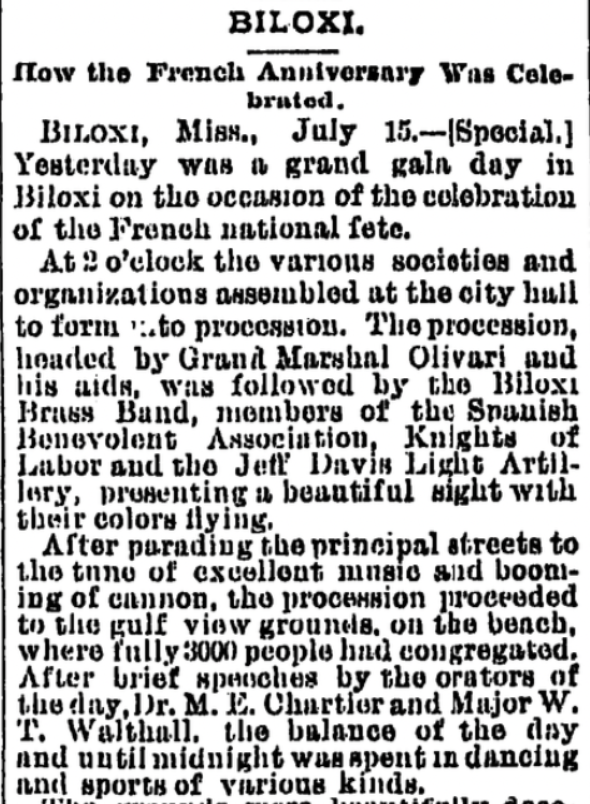
[TDP, July 16, 1887, p. 1]
1888
In January, Dr. R.D. Murray was ordered by the US Marine Hospital Service at Key West, as his service at Ship Island quarantine station had expired.(The Biloxi Herald, January 21, 1888, p. 8)
The Colored Teacher's institute met in the Handsboro school house on January 14th. The work of the 3rd institute was assigned as follows: W.A. Howard-spelling and reading; L.C. Henry-geography and history; W.P. Locker-arithemetic and grammar; J.H. Dale-natural philosophy and physiolgy. Pass Christian was selected as the next meeting place.(The Biloxi Herald, January 25, 1888, p. 8)
In February, the Mississippi House passed a bill authorizing the removal of the Ship Island Quarantine station. It had passed the Senate earlier. $45, 000 was appropriated for the removal project.(The Biloxi Herald, February 25, 1888, p. 8)
In January, the new Quarantine Station in the Chandeleur Islands was completed by carpenters and laborers from Biloxi and the doctor and his baggage were relocated from Ship Island to the new station. The move resulted from the general feeling that the Ship Island quarantine station was a constant menace and cause for alarm to those living at a distance and deterred them from visiting the Mississippi coast in the summer vacation months.(The Biloxi Herald, February 15, 1888, p. 8)
In February, Harry T. Howard (1856-1930) and Genevieve Cottraux ruled Carnival at NOLA.(The Times Picayune, February 20, 1966, p. 117)
In March 1888, Biloxi was described as follows: Standing on the front gallery of the Montross Hotel one looking to the Gulf would see the line of unsightly bath and oyster houses, dilapidated wharves, and high piles of oyster shelves. If the bath and oyster houses are to remain in cannot they be made neat and handsome and the large oyster piles-are they to remain and offend the eyes and noses of the denizens and visitors? The 'passenger depot' at this place of the L&N RR is a disgrace to the town and the road.(The Biloxi Herald, March 17, 1888, p. 8)
In February, Harry T. Howard (1856-1930), Captain of the Jeff Davis Light Artillery, was been promoted to Major, 1st Battalion of the Mississippi National Guard. Constantine Olivari (1841-1894) was elected Captain of the Jeff Davis Light Artillery in March to replace Captain Howard. Captain Olivari received his commission from Governor Lowry in late May.(The Biloxi Herald, February 14, 1888, p. 8, March 10, 1888, p. 8 and June 2, 1888, p. 8)
The Lamar Guards, a military company of heavy artillery, was organized at Biloxi in January. Officers were: Henry J. Meaut (1842-1934), Captain; Carey Holliman (1860-1935) 1st Lieutenant; Thomas D. Bachino (1861-1891), 2nd Lieutenant; Joseph Ott (1855-1932), Sgt.-at-Arms; and Dan MCDonald, secretary. The officers were commissioned by Governor Robert Lowry (1831-1910) in March. Some of the Springfield Rifles and cartridges for the Lamar Guards arrived in February. Other founding members were: Dan Markey (1855-1900); Peter Gillen (1859-1898) M.J. Grady (1841-1898); Oscar Meaut (1859-1935); Joseph Arguelles (1865-1944); Sam Shaw; and John W. Henley (d. 1918).(The Biloxi Herald, January 21, 1888, p. 1, February 11, 1888, p. 8 and March 3, 1888, p. 8)
Raymond Caillavet (1838-1898), contractor, built a large storage house for the Biloxi Artesian Ice Manufacturing Company.(The Biloxi Herald, February 18, 1888, p. 8)
The City of Biloxi enacted a new city charter, which was approved by the State legislature in early February.(The Biloxi Herald, January 14, 1888, p. 8, February 11, 1888, p. 1 and March 11, 1888, p. 9)
The Republican Executive Committee of Harrison County, Mississippi met at Mississippi City on March 3rd. John Lyons was the executive committee chairman.(The Biloxi Herald, February 25, 1888, p. 8)
John Walker was elected Mayor of Biloxi over William. P. Murray (1868-1895), Emile Laudner (1841-1890), and Raymond Caillavet (1838-1898).(The Biloxi Herald, March 11, 1888, p. 9)
The Biloxi Artesian Ice Manufacturing Company is now prepared to take ice orders from all along the Coast.(The Biloxi Herald, March 31, 1888, p. 8)
In January John A. Aniello (1848-1901), Italian immigrant from Corsica and inventor, was granted a patent on a life boat by the US Patent Ofice. In March while at New Orleans, he was advertising his patented life boat in Biloxi. In 1900, Aniello won the gold medal, a diploma, and $20,000 for his life boat at the World's Exposition in Paris competing with over 110 over boats. Mr. Aniello died in September 1901 at Havre, France. He had returned to France to defend his victory after it had been challenged by his competition.(The Biloxi Herald, February 4, 1888, p. 8, March 17, 1888, p. 8 and The Daily Picayune, January 5, 1901, p. 3 and October 4, 1901, and The NOLA Item, March 6, 1913,p. 1)
The Gulf View Hotel was leased by P.J. Montross (1841-1897) of the Montross Hotel.(The Biloxi Herald, April 7, 1888, p. 8)
Hugh McCallum, watchmaker and jeweler, will occupy will occupy the new building being built by J. R. Harkness for Dr. James J. Lemon on the south part of his drugstore lot.(The Biloxi Herald, April 14, 1888, p. 8)
Nielsen's Photo Gallery which was built in March opened on Reynoir Street near the L&N Depot. Professor Fitch, an experienced photographer, will be in charge.(The Biloxi Herald, March 17, 1888, p. 8 and April 14, 1888, p. 8)
In April, W.T. Walthall (1820-1899), Biloxi resident and veteran newspaperman, lecturer, yellow fever volunteer, who assisted Jefferson Davis with The Rise and Fall of the Confederate Government, was named Consul to Demerara, now a part of Guyana in South America, by President Cleveland. His salary was $3000 per annum. Mr. Walthall expired on May 20, 1899 in Vicksburg, Mississippi.(The Biloxi Herald, April 21, 1888, p. 1 and The Daily Picayune, May 21, 1899, p. 12)
L&N RR erecting a freight depot and refurbishing the old building for passenger traffic with separate waiting rooms for male and female transients.(The Biloxi Herald, May 12, 1888, p. 8)
The Scheffer House has been repaired and in first class condition to receive guests.(The Pascagoula Democrat-Star, May 28, 1880, p. 3)
Achille J. Chiapella (1862-1936) sold his Four Seasons Hotel to the Wilkinson Brothers. It opened on June 2nd as the Wilkinson Hotel.(The Biloxi Herald, May 26 and June 2, 1888, p. 8)
Jefferson Davis returned to Beauvoir from his cotton plantation at Briarfield.(The Biloxi Herald, June 30, 1888, p. 8)
Charles Gayarre, prominent Louisiana historian, was in Biloxi to visit the Reverend Doctor Hinsdale.(The Biloxi Herald, July 28, 1888, p. 8)
The Biloxi and Ocean Springs Yacht Club was organized through the relentless efforts of Colonel W.A. Fonda. John D. Bachino, commodore; W.A. Fonda, vice-commodore; and T.K. Reed, secretary.(The Biloxi Herald, August 11, 1888, p. 1)
The Dunbar & Company cannery at Bay St. Louis is at a dead standstill like the Mississippi City cannery. Biloxi canneries run and prosper. Why can't the others?(The Biloxi Herald, November 3, 1888, p. 8)
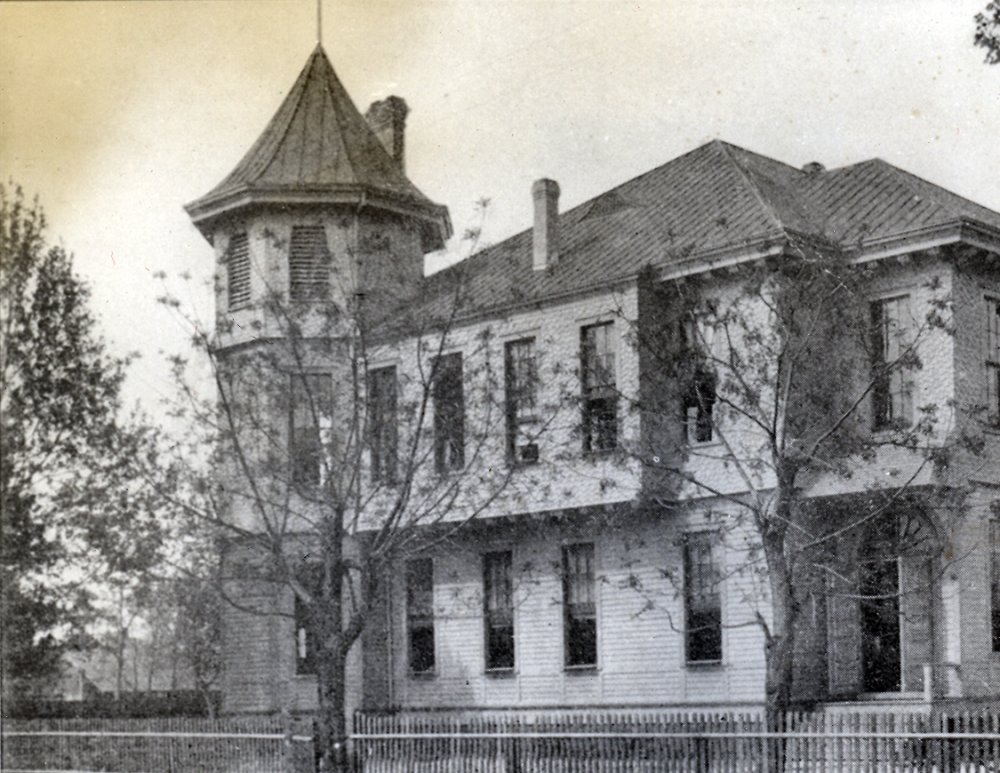
Howard Memorial School
[Gift of Frank T. Howard (1855-1911 and Harry T. Howard (1856-1930) which was built and designed by John R. Harkness & Son in 1888 for $10,000]
John R. Harkness has taken contract to build the new public school building, which was donated by the Howard family.(The Biloxi Herald, August 4, 1888, p. 8)
The Biloxi and Ocean Springs Yacht Club was organized in August. John D. Bachino, commodore; W.A. Fonda, vice-commodore; and T.K. Reed, secretary.(The Biloxi Herald, August 11, 1888, p. 1)
C.F. Theobald, secretary of the School Board, announced the following teachers and salaries for the 1888-1889 school year: Charles Dunbar Lancaster (1841-1922), principal-$60 per month; Mrs. Sehnhora Dodd Booth, 1st assistant-$35 per month; Miss. F.H. Walthall-$30 per month; Miss Edna Holley-$30 per month; Miss Molie T. Rodenberg-$25 per month.(The Biloxi Herald, October 6, 1888, p. 8)
New building erected between Delauney [G.E. Ohr] and Magnolia on Pass Christian Street [Howard Avenue] by John R. Harkness will be open next month as a clothing and notion store.(The Biloxi Herald, October 27, 1888, p. 8)
George G. Day, former manager of the Gulf View Hotel, left for Florida.(The Biloxi Herald, November 3, 1888, p. 8)
L&N RR with J.T. Harahan, General Manager, and an inspection party aboard made the run between Beauvoir and Biloxi at the rate of 65 1/2 miles per hour.(The Biloxi Herald, November 24, 1888, p. 8)
Sixteen Biloxi carpenters and laborers were employed to erect the new Quarantine Station on the Chandeleur Islands.(The Biloxi Herald, November 24, 1888, p. 8)
John Henry Keller (1830-1908), NOLA soap merchant and Biloxi real estate investor, married Martha 'Mattie Washington Silk (1853-1913) at NOLA on November 15, 1888.(The Biloxi Herald, November 24, 1888, p. 8)
Total enrollment in the Biloxi Public School for the year to date in 202 students. Average attendance is 137 students.(The Biloxi Herald, November 24, 1888, p. 8)
The Ocean View Hotel of C.F. Theobald was leased to H. Edwards and plans to open January 1, 1889.(The Biloxi Herald, December 1, 1888, p. 8)
The Tegarden Hotel at Mississippi City burned to the ground on November 26th. It had been recently leased to Mrs. Alexander.(The Biloxi Herald, December 1, 1888, p. 8)
F.W. Elmer requested from the US Secretary of the Treasury that Biloxi be made a Port of Entry.(The Biloxi Herald, December 15, 1888, p. 8)
Harry T. Howard (1856-1930) was in town and took several photographic images of the new school house.(The Biloxi Herald, December 15, 1888, p. 8)
1889
The Reverend Robert H. Hinsdale expired on January 9th. He was at the Church of the Redeemer from 1883 until his demise. On his death bed, Reverend Hinsdale requested that Harry T. Howard erect a new Episcopal Church on the beach at Biloxi.(The Daily Herald, January 9, 1913, p. 1)
The new, modern Howard Memorial public school building on Main Street, a gift from of Frank T. Howard (1855-1911) and Harry T. Howard (1856-1930) to the citizenry of Biloxi, was dedicated on March 22nd. It was built and designed by John R. Harkness & Son in 1888 for $10,000.(The Daily Picayune, March 22, 1889, p. 8)
Biloxi had a large fire occur in the Central Business District on June 5th. Damage estimated at $75,000. The fire started in the Herald Building. Major losses suffered by: Mrs. C.M. Rugge who lost two-story residence valued at $9000; Constantine Olivari (1841-1894) who lost his two-story residence, ship chandlry business, dry goods and groceries on the corner of Lameuse Street and Pass Christian Street valued at $8000; Dr. James J. Lemon lost his drug store and home worth $7500. The Post Office building of Louis Holley was also destroyed. Mobile, Alabama sent two fire engines on a special train, but they arrived after Biloxi firemen had the conflagration extinguished.(The Daily Picayune, June 6, 1889, p. 1)
John W. Treloar (1846-1897), described as 'boss fisherman of the Coast', and in the employ of Paul Gelpi & Sons of NOLA, candy manufacturers, left Biloxi on an extended trip to the Northwest in the interests of his employer, Paul J. Gelpi (1848-1920).(The Daily Picayune, August 19, 1889, p. 8)
Jefferson Davis (1808-1889) died at New Orleans on December 6th. His remains were interred in the Metairie Cemetery. His corporal remains were later interred on May 31, 1893 at Richmond, Virginia.
1890
Emile Laudner [Ladner] (1840-1890) died at his home on Pass Christian Street, now Howard Avenue, on February 26th. Two term Biloxi Mayor [1883-1884 and 1887-1888]. Pioneer in the seafood industry at Biloxi and founder of the Deer Island Oyster and Fish Company. In the seafood business as early as September 1876.(The Biloxi Herald, March 1, 1890, p. 1 and The Biloxi Mirror September 9, 1876, p. 3)
Joseph C. DeLamarre (1855-1931), Town Marshal and Sanitary Inspector, began his sanitary inspections on May 1st as required by law and advised all Biloxi property owners to have their yards and closets clean to "avoid trouble". (The Biloxi Herald, April 24, 1890, p. 4)
The Knights of the Golden Eagle organized a castle at Biloxi in May with 32 members. Judge Anthony Sambola (1836-1903) and Fred Holyland (1834-1894) of NOLA were the officers that assited in the formation of the Biloxi chapter, the first in Mississippi. Judge A.B. DeLamarre was appointed Deputy Supreme Chief of the State of Mississippi.(The Biloxi Herald, May 24, 1890, p. 4)
In May, the Biloxi fire companies met and decided that the annual Firemen's Parade at Biloxi would be held on September 19th, the day that the Biloxi Fire Company No. 1 was officially organized in 1883. The Biloxi Herald nominated Phil McCabe as Biloxi's first fire chief.(The Biloxi Herald, May 24, 1890, p. 4)
The framework for the new Opera House is going up and when completed it will be the largest building in Biloxi. John R. Harkness is working rapidly for its completion. The building contract called for the Opera House to cost $5000 when finished and furnished.(The Biloxi Herald, June 7, 1890, p. 4 and June 19, 1890, p. 4)
American Fire Company No. 3 [colored] entertained at the Baptist Church for the benefit of the relief fund.(The Biloxi Herald, June 28, 1890, p. 4)
Aleck Horn and Aleck Redon went to Pass Christian in June and persuaded 160 people to sign their pettion asking that the Customs House be removed from Bay St. Louis to Biloxi.(The Biloxi Herald, June 28, 1890, p. 4)
The Howard Guards military ball and second competitive drill was held in November and was well attended. Captain H.C. Meaut judged that Sgt. William Harkness deserved the gold medal.(The Biloxi Herald, November 22, 1890, p. 4)
1891
The New Orleans Loan, Building and Savings Association opened a branch in Biloxi. John Walker, pres.; P.J. Montross, v.p.; Ernest Desporte, sec.-treas.(The Biloxi Herald, May 10, 1891, p. 2)
Lopez, Dunbar's Sons & Company advertising to buy figs. Had agents at Grand Bay, Alabama, Scranton [Pascagoula], and Ocean Springs. (The Pascagoula Democrat-Star, June 19, 1891, p. 2)
The new plant of the Barataria Canning Company was completed in July. H.R. Gogreve, president; Isidore Hechinger, vice pres.; H. Bentz, treasurer; Isidore Heidenheim, secretary; and H. Edwards Jr., superintendent.(The Biloxi Herald, July 11, 1891, p. 4)
The Public School had an enrollment of 264 students. J.L. Ladd, principal; Faculty: Miss Josie Santini; Miss Melancon; and Miss Edna Holley.(The Biloxi Herald, December 26, 1891, p. 8)
1892
The old Bellande building near the L&N depot has been demolished and the foundation is being laid for a new two-story edifice.(The Biloxi Herald, January 9, 1892, p. 8)
Weather reports at Biloxi were posted on the outside door of the US Post Office after arriving on the morning L&N train.(The Biloxi Herald, January 16, 1892, p. 4)
On March 18th, a fire of incendiary origin destroyed the sash, door and blind factory of M.L. Vazquez north of the railorad. Loss estimated at $2000 with $1000 insurance by Phoenix. A small house valued at $400 and owned by Collier also lost.(The Biloxi Herald, March 19, 1892, p. 4)
The Biloxi Public School had an enrollment of 271 students and average attendance since December 1891 was 197 students. J.L. Ladd, principal; Faculty: Miss Ladd, Miss Josie Santini; Miss Melancon; and Miss Edna Holley.(The Biloxi Herald, April 9, 1892, p. 2)
On May 18, 1892, the new Episcopal Church of the Redeemer at Biloxi was consecrated to the memory of the Reverend R.G. Hinsdale by Bishop Thompson of Mississippi and Bishop Sessums of Louisiana. Harry T. Howard (1856-1930) donated the land and building.(The Biloxi Herald, May 21, 1892, p. 1)
Another Baptist church has been organized in Biloxi and will be known as the Washington Street Baptist Church and led by the Reverend R.M. Guy. The old ME Church building has been acquired and will be used for worship services.(The Biloxi Herald, July 9, 1892, p. 4)
On July 26,1892, the great New Orleans philanthropist, John Henry Keller (1830-1908), himself not a Presbyterian, donated Lot 1 (50 feet by 150 feet)-Block 6 of Keller's tract to the Biloxi Presbyterian Church. The church was located on East Howard Avenue east of the old Biloxi Public High School. W.L. Covel (1836-1926) was contracted to erect the 'small and modest building" of the newly organized congregation. The deacons and elders of the Biloxi Presbyterian Church, among them Bemis O. Bailey (1898-1969), an Ocean Springs native, sold their property to the City of Biloxi in late December 1940, for $3659.(Harrison Co., Ms. Land Deed Bk. 28, p. 205 and The Biloxi Herald, July 2, 1892, p. 1 and July 16, 1892, p. 4)
The Biloxi baseball boys whipped the Ocean Springs Browns 24 to 1 at the Depot Green in Biloxi.(The Biloxi Herald, August 27, 1892)
By September 1892, Biloxi had three fire companies: Volunteer Fire Company No. 1, the oldest, led by F.W. Elmer; Mechanics Steam Fire Co. No. 2, led by Dr. J.J. Lemon; and the Mississippi Hook & Ladder Fire Company No. 1 under H.V Lizana.(The Daily Picayune, September 20, 1892, p. 9)
H. Eugene Tiblier Jr. (1866-1936), found a sunken French vessel in the Back Bay of Biloxi beneath the shallow water over the family oyster lease, near the L&N Railroad bridge. Captain Tiblier hired Joseph "Pep" Suarez (1840-1912), who owned the schooner, Maggie, to assist in the salvage of artifacts from the hold of the sunken ship. His sons, Albert Tiblier and Vital Tiblier, dove on the oyster bank during the salvage operations. According to a report of The Pascagoula Democrat-Star of September 23, 1892, the Tiblier family recovered four cannons, swords and scabbards, some muskets, cannon balls, wooden sheaves, fire brick, iron braces, and rock ballast.
Patrick Kennedy (1845-1913) began shipping raw oysters in November as P. Kennedy & Company.(The Biloxi Herald, November 12, 1892, p. 1)
On December 23rd, Edward J. Buck, former cashier of the Manufacturers' National Bank of Pittsburg, Kansas met at the Montross Hotel with affluent Biloxians to organize the Bank of Biloxi. $18,000 of capital stock was soon raised. Officers of the Bank of Biloxi were: C.F. Theobald, pres; Laz Lopez, v. pres; and E.J. Buck, cashier. Board of Directors: John Walker; W.K. M. Dukate; Nicholas Voivedich; Charles edding; O.M. Nielson; Isidore Heidenheim; Edward Glennan; and Sam Picard.[The Biloxi Herald, December 17, 1892 and December 24, 1892 and January 21, 1893, p. 4]
1893
John Eistetter (1856-1904) began laying the foundation for a two-story building for Mr. Herbelin on the corner of Howard Avenue and Lameuse Street. J.R. Harkness was the contractor.(The Biloxi Herald, January 21, 1893, p. 8)
Louis Rosenthal (1851-1942), native of Prussia and editor and manager, commenced The Biloxi Blizzard in February. Published by Biloxi Publishing Company and cost $1.50 per year.(The Biloxi Herald, February 4, 1893, p. 10)
The Bank of Biloxi was chartered on February 21st.(Harrison Co., Ms. Charter Bk. 2, p. 69)
In April, John R. Harkness (1830-1903) was contracted by Lopez, Dunbar's Sons & Co. to construct a new, five thousand dollar, 18,000 square-ft.. cannery on the former site of the old one. Two-story, mansard towers on each end functioned as office space.(The Biloxi Herald, April 15, 1893, p. 1)
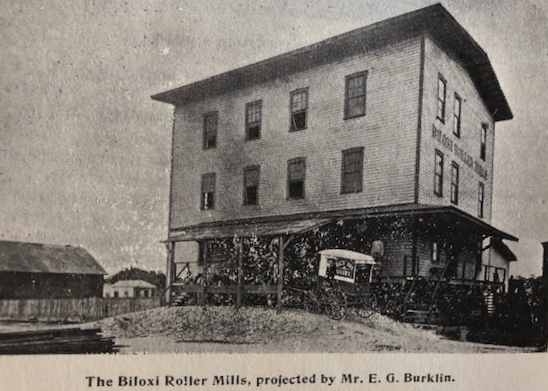
In April, the Biloxi Milling Company, commenced operations making flour and meal. It was founded by Missourians, Edward G. Burklin (1860-1920+), James B. 'Buck' Chinn (1857-1912), R.D. Chinn, and Mr. Brewton.(The Biloxi Herald, January 7, 1893, p. 8 and April 22, 1893, p. 1)
In April J.R. Harkness & Sons announced plans to build a steam planning and milling plant in the rear of the Opera House on Pass Christian Street and Magnolia Street.(The Biloxi Herald, April 22, 1893, p. 1)
In April, J.R. Harkness & Sons relocated the Episcopal Church from Pass Christian Street to the Beach.(The Biloxi Herald, April 22, 1893, p. 1)
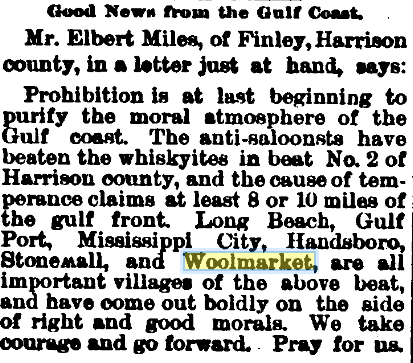
[The Mississippi Leader [Brookhaven], May 16, 1893, p. 3]
In late May, the corporal remains of Jefferson Davis (1808-1889) were sent from New Orleans by a L&N funeral car to Richmond, Virginia for burial on May 31st in the Hollywood Cemetery.(The Biloxi Herald, May 29, 1893, p. 1)
The Seashore Academy, a boy's boarding school, opened with Dr. G.S. Roudebush, school master. It was located about 1500 feet west of the Biloxi Lighthouse.(The Biloxi Herald, July 1, 1893, p. 8)
The Mexican Gulf Coast Illustrated written by T.H. Glenn of Ocean Springs is complete and being bound.(The Biloxi Herald, July 8, 1893, p. 8)
In July 1893, Jacob Elmer and William Gorenflo donated land east of Main Street on Back Bay to the Mayor and City of Biloxi for a street called ‘North Biloxi Street’. This 40-foot thoroughfare ran 1250 feet south of Bay Street [Bayview Avenue] and turned west for about 300 feet until it intersected Main Street.(Harrison Co., Mississippi Land Deed Bk. 29, p. 340)
The Columbian Exposition Edition, an eight page and eight column journal, was published by The Biloxi Herald in July. G.W. Wilkes, publisher, and W.L. Gilbert were responsible for this splendid publication.(The Biloxi Herald, July 22, 1893, p. 1 and July 29, 1893, p. 1)
The Biloxi Canning Company is having two large barges built at the shipyard of Francis Codina at Pascagoula.(The Biloxi Herald, July 29, 1893, p. 8)
In late July, The Beach House, a new hotel on the beach, was completed for occupancy by J.R. Harkness, contractor, for Mrs. M.E. Drysdale, the owner.(The Biloxi Daily Herald, July 29, 1893, p. 8)
The Blizzard, a weekly newspaper, was edited and managed by Louis Rosenthal. Cost $1.50 per year.
E.G. Burklin (1860-1931) of Vandalia, Missouri agreed to install 45 street lights of 32 candle power to the City of Biloxi.(The Biloxi Herald, September 30, 1893, p. 1)
The October Storm or Cheniere Caminada Storm hits near Grand Isle, Louisiana on October 1st.
The white Public school opened on October 16th with 85 boys and 75 girls. Faculty composed of: C.D. Lancaster, principal; Miss Josie Santini, Miss Mollie Rodenberg; Miss Edna Holley, Mrs. S. Booth, and Miss Rosa Andrews. Salaries set for teachers as follows: C.D. Lancaster-$85 per month; Josie Santini-$45 per month; and Mollie Rodenberg, Rosa Andrews, and Mrs. S. Booth $40 per month.(The Biloxi Herald, October 14, 1893, p. 1 and October 21, 1893, p. 8)
The Colored Public school was to open on the first Monday in November.(The Biloxi Herald, October 14, 1893, p. 1)
Casimir J. Harvey (1845-1904) of Back Bay [D'Iberville] commenced his ferry operation across Back Bay to Biloxi on December 2nd. His vessel was called ‘the Shrimp’. Captain Ed Richards took over the rope or skiff ferry and handled the oars.(The Biloxi Herald, December 2, 1893, p. 1)
The Montross Hotel installed electric lights in December.(The Biloxi Herald, December 9, 1893, p. 8)
1894
Joseph Thomas 'J.T." Maybury [1840-1894), native of Baltimore and prominent Biloxi seafood canner, died at Biloxi on 6 January. His internment was in the Magnolia Cemetery at Mobile, Alabama. Mr. Maybury founded at Pascagoula, Mississippi in late October 1880, the Mexican Gulf Canning Company, which was chartered at Mobile, Alabama. After its liquidation, he founded Maybury & Foster, another seafood cannery also located in Pascagoula.[The Biloxi Herald, January 6, 1894, p. 1]
The City Council appointed Aldermen Gleason, Dulion, and Louge to meet with land owners on Front Beach between Lameuse Street and Porter Avenue to secure 40 feet of land to build a road.(The Biloxi Herald, January 6, 1894, p. 1)
The City Council refused the petition of Casimer J. Harvey to have the exclusive privelege of a landing at the foot of Reynoir Street on Back Bay.(The Biloxi Herald, January 6, 1894, p. 1)
W.K.M. Dukate returned from Baltimore with fifty Bohemians to work the remainder of the seafood season at the Lopez, Dunbar's Sons & Co. factory. Harry Edwards of the Barataria Canning Co. left this week also for Baltimore on business to employ about fifty people.(The Biloxi Herald, January 20, 1894, p. 8)
The Columbia, Lumberton & Gulf Railroad was recently chartered. The railroad will tap for ninety miles some of the finest pine lands in the State. Plans to connect with the Gulf & Ship Island RR. at Lumberton, Mississippi.(The Biloxi Herald, January 20, 1894, p. 8)
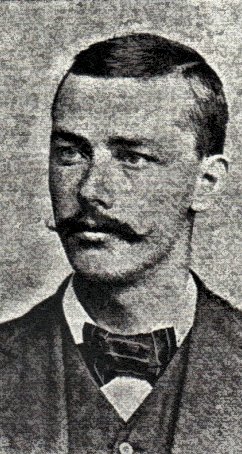
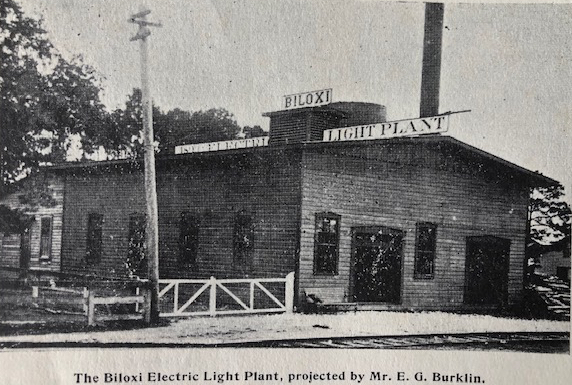
Edward G. Burklin
The Biloxi Electric Light Company was chartered on February 3rd by Edward G. Burklin (1860-1931), Ed Glennan (1854-1933), J.W. Swetman (1863-1937), J.J. Lemon (1825-1915), Lazaro Lopez (1850-1903) , John C. Bradford (1855-1928), et al.(Harrison Co., Ms. Charter Bk. 2, p. 116)
Constantine Olivari (1841-1894), Italian immigrant merchant, civic and military leader, expired on February 2nd.(The Biloxi Herald, February 10, 1894, p. 8)
The Biloxi and Back Bay Bridge Company was incorporated on June 2, 1894. It was organized to erect and maintain a bridge across the Back Bay of Biloxi. Incorporators: Edward Glennan; William Gorenflo; J.A. Bousquet; D.M. Mayers; W.A. White; R.V. Krohn; J.A. McCrary; C.E. Theobald; Jeff Mullholland; Laz Lopez; F.W. Elmer; S. Picard; A.M. Dahlgren; W.K.M. Dukate; J.W. Swetman; O.S. Williams; I. Heidenheim; E.G. Burklin; Frank Voivedich; H.T. Howard; J.L. Gill; J.R. Harkness; and E.W. Morrill.[The Biloxi Herald, June 2, 1894, p. 1 and Harrison Co., Ms. Charter Bk. 2, p. 186]
In late April, Chrutti's Shipyard on Back Bay launched a double-hull, ferry boat [66 feet with a beam of 26 feet] to be used to cross the Back Bay of Biloxi.(The Biloxi Herald, April 28, 1894, p. 8)
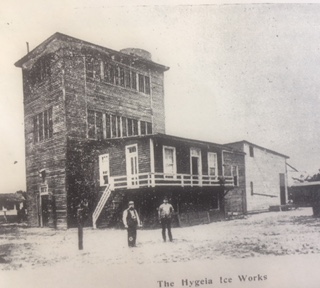
In May 1894, the Hygeia Ice Works, built for $35,000 and owned by the De La Vergne Manufacturing Machine Company of New York, was operating at Biloxi west of the railroad depot. The plant had the capacity to make 15 tons of ice each day with Charles McCormack was their local representative.(The Biloxi Herald, May 19, 1894, p. 8)
The Biloxi and Back Bay Bridge Company was incorporated in June 1894. It was organized to erect and maintain a bridge across the Back Bay of Biloxi. Incorporators: Edward Glennan; William Gorenflo; J.A. Bousquet; D.M. Mayers; W.A. White; R.V. Krohn; J.A. McCrary; C.E. Theobald; Jeff Mullholland; Laz Lopez; F.W. Elmer; S. Picard; A.M. Dahlgren; W.K.M. Dukate; J.W. Swetman; O.S. Williams; I. Heidenheim; E.G. Burklin; Frank Voivedich; H.T. Howard; J.L. Gill; J.R. Harkness; and E.W. Morrill.[The Biloxi Herald, June 2, 1894, p. 1]
President Grover Cleveland has signed the bill to approve the construction of a bridge across the Back Bay of Biloxi.[The Biloxi Herald, September 1, 1894, p. 1]
In September, Dr. James J. Lemon (1825-1915), physician and pharmacist, was named the British vice-consul at Biloxi. His duties were to represent the commercial and personal interest of the British Crown. In October, he was presented the British flag in a ceremony at Ship Island by Captain Maddrell of the English steamship County of York. A.M. Dahlgren (1856-1906), collector of customs and Dr. G.M. Guiteras, Marine Hospital surgeon were also present at the ceremony.(The Biloxi Herald, October 6, 1894, p. 8)
On October 12th, Biloxi's Commercial District was inflicted losses of about $75,000 when a large fire commenced in the two-story, J.W. Swetman Building on Pass Christian Street. Big losers were: S. Picard-$25,000; J.W. Swetman-$8000; G.E. Ohr Sr.-$5000; W.K.M. Dukate-$4500; and the pottery of G.E. Ohr Jr. (1857-1918)-$3000.(The Biloxi Herald, October 13, 1894, p. 8)
In late November, Lyman Bradford opened a general merchandising store on Back Bay at the corner of Lameuse Street.(The Biloxi Herald, November 24, 1894, p. 8)
Sumner W. Rose (1858-1947), Socialist and leader of the National Industrial Colony arrived at Handsboro with families from Colorado, Connecticut, Indiana, Iowa to engage in truck farming, manufacturing and publishing.(The Biloxi Herald, November 24, 1894, p. 8)
1895
Louis Rosenthal (1851-1942) sold The Biloxi Blizzard to Austin M. Dahlgren (1856-1906), collector of the port, in late January 1895. The conveyance occurred without consultation from Monsieurs Edward Glennan (1854-1933) and Charles Redding (1857-1926). These gentlemen owned the physical assets of Rosenthal’s late journal.(The Biloxi Herald, January 26, 1895, p. 8)
City Ordinance No. 76 created the Biloxi Cemetery Association on February 4th. It was composed of G. Edward Parks, pres.; E.W. Morrill, treas.; I. Heidemheim, sec.; and B.R. Clemens. Charles Berger was hired as sexton.(The Biloxi Herald, February 16, 1895, p. 4)
In February, Frank T. Howard (1855-1911) and Lydia Fairchild ruled Carnival at NOLA.(The Times Picayune, February 20, 1966, p. 117)
Former City Marshal, assessor and tax collector, William P. Murray (1868-1895), spouse of Emma R. Caillavet (1871-1955), died on February 26th.(The Biloxi Herald, March 2, 1895, p. 8)
In late February, work commenced by the G.C. Taylor & Company on the new City Hall on Main Street. When excavation began on the foundation, Mr. Taylor had difficulty finding local labor and went to Meridian and returned with eleven laborers, as only five Biloxians would work for $1 per day, the unskilled labor rate. Most Biloxi day laborers expected to be paid $1.25 to $1.50 per day.(The Biloxi Herald, March 2, 1895, p. 8)
The Biloxi Banner, a local journal was established by W.E. Champlin (1866-1895+) at Biloxi on March 16th. In 1892, Mr. Champlin had commenced The Mentor at Handsboro, Mississippi.(Dyer, 1895, 'Biloxi')
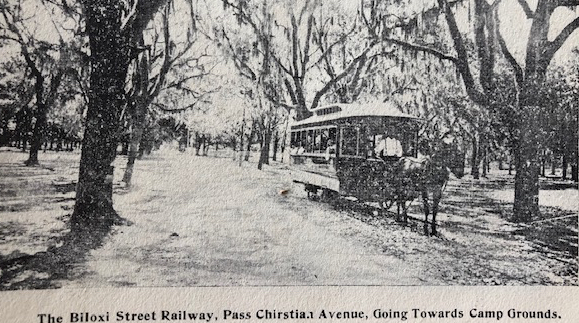
The Biloxi Railway was established by Dr. J.J. Lemon, president; J.C. Bradford, vice-pres.; E.G. Burklin, general mgr. and superintendent; Col. E.W. Morill, sec.-treas.; and W.H. Maybin, gen. attorney. Laying of track was to commence shortly as cars, rails, ties, etc. had been acquired. $8000 worth of company stock had been sold.(The Biloxi Herald, March 30, 1895, p. 8)
'The Westbrooks', local baseball club of Ocean Springs, lost to the 'Lemons' of Biloxi 29 to 7 at Ocean Springs. The battery for Ocean Springs was Fayard, Seeman (sic), and Katchardt (sic). Biloxi's battery was Clark and Henley. Clark struck out ten Westbrooks, while Seeman (sic) fanned only two 'Lemons'.(The Biloxi Herald, May 11, 1895, p. 8)
The L&N Railroad completed two new railroad stations on the east and west end of Biloxi. The Coast train and Excursion trains on Wednesday and Sunday will stop at both places. The L&N has named these stations as the Oak Street Station (east) and the Gill Avenue Station (west). Local citizens suggested the names Summerville (east) and Oakmere (west), but they were rejected by the railroad.(The Biloxi Herald, May 11, 1895, p. 8)
Morris and Eaton have leased the Arcade House on the Beach and will conduct a first class hotel.(The Biloxi Herald, May 11, 1895, p. 8)
The Mississippi State Press Convention was held at Biloxi in late June. The visiting journalists were impressed with the hospitalty of Biloxians and were taken to Ship Island, the G.E. Ohr Pottery, a terrapin farm, canneries, and Beauvoir. Additonal entertainment was provided by the Iroquois Club and the Business Men's League and a fireworks display.(The Biloxi Herald, June 25, 1895, p. 5)
Henry Fleger, manager of the Biloxi Broom factory, related that broom corn grown on Back Bay was superior in many ways to Tennessee broom corn. He had an exhibit of brooms made with the locally grown corn.(The Biloxi Herald, August 24, 1895, p. 8)
Horse drawn street cars began running on Reynoir Street to the Back Bay in early September.(The Biloxi Herald, September 7, 1895, p. 8)
Harriet A. Rodenberg (1822-1895), widow of John N. Rodenberg (1821-pre 1870), expired in early Ocotber.(The Biloxi Herald, October 5, 1895, p. 8)
Nicholas Voivedich (1821-1895) was born at Mahon on the Spanish isle of Menorca and died on November 10th. Voivedich had married Clementine Carco (1820-1916) and became a well-known Biloxi businessman and real estate owner. His most prized real estate in Biloxi was the block bounded by West Howard, Reynoir Street, Fayard Street and the Sisters of Mercy Convent-all south of West Howard Avenue. He also owned a large tract of land with 188 feet on Back Bay and running south to Division Street which was acquired in August 1856. It was adjacent to what became Back Bay Park.(Harrison Co., Mississippi Chancery Court Cause No. 855-1895 and Land Deed Bk. 7, p. 729)
1896
In January, Governor Anselm J. McLaurin (1848-1909) began his four year term as Mississippi’s chief executive. His term ended January 1900.
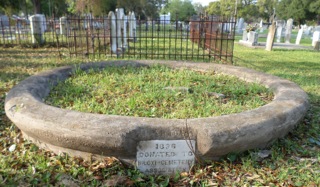
Florian Seal (1853-1927) opened the Gulf Coast Real Estate Agency in the Biloxi Herald building in March.(The Biloxi Herald, March 7, 1896, p. 8)
The Back Bay School ended its four month term in February with an enrollment of fifty-seven students. Average attendance was thirty-three because the 3rd Reader Class was transferred to the Central School. Senhora D. Booth, principal.(The Biloxi Herald, March 7, 1896, p. 8)
Marshal Joseph C. DeLamarre (1855-1931) resigned his post effective March 15th.(The Biloxi Herald, March 7, 1896, p. 8)
Peoples' Bank of Biloxi established in March. C.F. Theobald, pres.; Ed Glennan, vice pres.; and C.E. Theobald, cashier. Mosler Company will supply the safe.(The Biloxi Herald, March 7, 1896, p. 8)
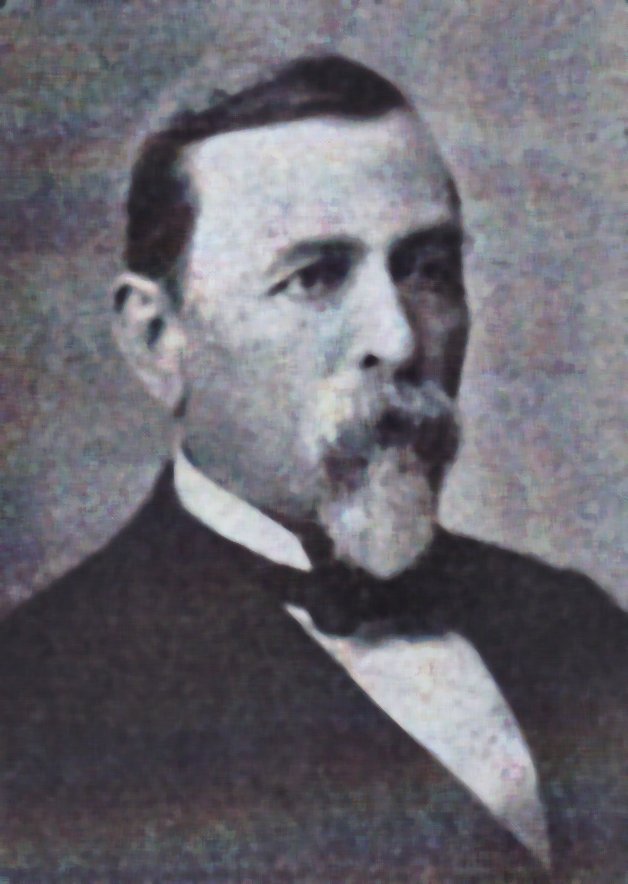
Captain John H. Miller
Captain John H. Miller (1847-1928) assumed editorial control of The Biloxi Herald on October 31, 1896 from George W. Wilkes (1854-1915). Captain Miller left the journal on May 1, 1898 when the co-partnership, G.W. Wilkes & Company, was dissolved leaving G.W. Wiles sole owner of The Biloxi Herald.(The Biloxi Herald, June 11, 1898, p. 1 and The Daily Herald, April 23, 1928, p. 2)
New City Hall dedicated in late April.(The Biloxi Herald, April 25, 1896, p. 1)
Bernard Picard (1853-1896), Jewish merchant, native of Alsace and proprietor of Picard's Emporium, died on May 23rd.(The Biloxi Herald, May 23, 1896, p. 8)
Construction on Pass Christian Street [Howard Avenue] was well underway by mid-year. The Lazaro Lopez residence is almost complete, John Eistetter's new brick building is rapidly under construction; on 24 July, Mechanics Fire Company No. 2 will dedicate their new firehouse; Dr. Saucier is completing his wood-framed structure and the Herbelin warehouse in its final stages; the McCabe Building on the NW/C of Lameuse and Pass Christian Street will be removed for the erection of the new, two-story, Roman brick of the Peoples Bank.[The Biloxi Herald, July 18, 1896, p 1]
The City of Biloxi changed the name of Pass Christian Road to Howard Avenue by Ordinance No. 98, passed on August 5, 1896.(The Biloxi Herald, August 8, 1896, p. 1)
W.T. Harkness [1869-1941] was awarded the contract to build the new Peoples Bank Building on the N/W corner of Howard Avenue and Lameuse Street. The winning Harkness' bid was $6725 beating John Eistetter by a several dollars.(The Biloxi Herald, August 22, 1896, p. 8)
Eistetter & Kelly were awarded the contract to build a home for C.F. Theobald on the Beach and Main Street. Cost was to be about $5000.(The Biloxi Herald, August 22, 1896, p. 8)
On September 9, 1896, Lazaro Lopez, William Gorenflo, Daniel A. Nash, John C. Bradford, Raymond Caillavet and J.B. Lemon, Aldermen of the City of Biloxi, filed a libel suit in the Circuit Court of Harrison County, Mississippi against H.S. Evans, editor of the Biloxi Review and local correspondent for the Daily Picayune, and the following stockholders of the journal: Edward Glennan, Louis E. Gill, Charles Redding, W.P. Henley, and E.C. Joullian. The litagation alleged that an editorial by Mr. Evans damaged the character of these well known Biloxi citizens. The plaintiffs were seeking $20,000 in damages from the defendants.(The Biloxi Herald, September 12, 1896, p. 1)
R.D. Lamont, two-month, employee of The Biloxi Review, published by H.S. Evans, severed his relationship with the journal and returned to Montgomery, Alabama.(The Biloxi Herald, September 12, 1896, p. 8)
A.O. Burdin Sr. (1845-1901), ice dealer, was appointed by Governor Anselm J. McLaurin (1848-1909) as Alderman 2nd Ward replacing George W. Wilkes (1854-1915) who resigned before moving from the ward.(The Biloxi Herald, September 26, 1896 ,p. 3)
CSA Brigadier General Joseph Robert Davis (1825-1896), nephew of CSA President Jefferson Davis died at Biloxi on September 15, 1896. His corporal remains interred in the Biloxi City Cemetery. Margaret Green Davis (d. 1939), his spouse and Biloxi US Postmaster from March 1889 until 1897 died on January 15, 1939.(The Biloxi Herald, September 19, 1896, p. 1)
John A. Sutter, water well engineer, found a porous aquifer at 470 feet while digging a water well for Monsieurs White, Neville, Parsons, Venus, Carraway, Nash, Miller, and others. The well tested at the rate of 75 gallons per minute through a 2 1/2 inch pipe on the lot of Mr. White.(The Biloxi Herald, November 7, 1896, p. 8)
In November, the Back Bay Artesian Water Company was chartered by John Bradford, Arthur Reynoir, Mrs. A Richards, and Sam D. Shaw.(The Biloxi Herald, November 28, 1896, p. 8)
Captain John H. Miller mortally wounded Jules Soule, editor of The Biloxi Review on December 7th.(The Biloxi Herald, December 12, 1896, p. 8)
The People's Telephone Company of Biloxi was chartered in December by W.K.M. Dukate, Ernest L. Doyle, J.D. McKie, W. A. White, John Walker, and Ed Glennan.(The Biloxi Herald, December 5, 1896, p. 8 and The Daily Herald, November 17, 1948, p. 7)
On Christmas Day, the first horse races were held at the Gulf View Baseball Park and Race Track. The race track was built 40 feet wide and not to interfere with the baseball field. It was 1/3 of a mile plus 40 feet in length with the finish in front of the grandstand whether the race was 1/4 mile or 1/3 mile. It could also be adapted fro bicycle racing.(The Biloxi Herald, December 5, 1896, p. 8 and December 26, 1896, p. 8)
1897
The People’s Telephone Exchange held its organizational meeting at Biloxi on January 6, 1897. The company expected to be stringing lines and operating shortly. Officers elected were: John Walker, pres.; John Carraway, sec.-treas.; and Ernest L. Doyle, general manager. Board of Directors: Ernest L. Doyle; John Walker; Daniel A. Nash; W.K.M. Dukate; J.B. Chinn; J.C. Clower; J.D. McKie; W.H. Murphy; and John F. McCormick.(The Biloxi Herald, January 9, 1897, p. 1)
Dr. Anthony P. Champlin (1839-1897) died at Biloxi in early March. He had been a quarantine physician for several years and at the time of his demise was in charge of the Cat Island Quarantine Station.(The Biloxi Herald, March 15, 1897)
Peter Joseph Montross (1841-1897), proprietor of the Montross Hotel died at Biloxi on March 27, 1897. His corporal remains were sent to New Orleans for internment in the vault belonging to the Army of the Tennessee.(The Biloxi Daily Herald, April 3, 1897, p. 8)
John R. Harkness (1827-1903) has the contract to erect the residence of John C. Carraway (1873-1931) and William P. Burke (1858-1924) will build the house of Dr. Daniel A. Nash (1858-1904). Both structures are on the beach.(The Biloxi Herald, April 3, 1897, p. 1)
The Iroquois Club, a men's social was organized in April with Phil McCabe, president; J.J. Kennedy, secretary; and Louis E. Gill, treasurer.(The Biloxi Daily Herald, April 24, 1897, p. 8)
The Biloxi Business League was created on April 21st. W.K.M. Dukate (1852-1916), president; E.W. Morrill, vice president; J.P. Chinn, treasurer; and William F. Gray, secretary.(The Biloxi Daily Herald, April 24, 1897, p. 8)
Dr. Hyman McMacken Folkes (1871-1926) came to Biloxi to from Jackson to accept the post of Quarantine Officer at Ship Island.(The Biloxi Daily Herald, April 24, 1897, p. 8)
William C. Morgan and son leased the Montross Hotel in early May.(The Biloxi Daily Herald, May 8, 1897, p. 8)
John H. Miller (1847-1928), editor of The Biloxi Herald, was found not guilty in the manslaughter of Jules Soule.(The Biloxi Herald, July 3, 1897, p. 1)
Dan Markey replaced Arsene O. Bourdon Sr. as Biloxi's Fire Chief.(The Biloxi Herald, August 7, 1897, p. 1)
There were four new cases of Yellow Fever reported at Biloxi with no deaths. Dr. Juan Guiteras (1852-1925), government Yellow Fever expert, examined twenty-eight fever cases at Ocean Springs and reported that twenty-five were dengue fever and that he was unsure of the cause of the three others.(The Daily Picayune, September 9, 1897, p. 1)
John Stevenson Parkhurst (1829-1897) and Caroline Boardman Parkhurst (1832-1897), spouse, were murdered at their Back Bay Biloxi residence 'Parkhurst' on October 21st. 'Parkhurst' consisted of 120.81 acres comprising Section 20, T7S-R9W. It was acquired in September 1882 from Jacob Elmer and sold for $1600 to T.P. Dulion in August 1899 by Stephen L. Parkhurst and Emma McMeekin, sole heirs of John S. Parkhurst.(The Biloxi Herald, October 23, 1897, p. 1, October 30, 1897, p. 8, January 15, 1898, p. 5 and Harrison Co., Ms. Land Deed Bk. 19, p. 88 and Bk. 42,pp. 516-517)
1898
The Gulf View Baseball Park has been dismantled and is now a thing of the past.(The Biloxi Herald, January 15, 1898, p.8)
Raymond Caillavet (1838-1898), former Mayor, treasurer, councilman, and street commissioner, expired on February 16th.(The Biloxi Herald, February 19, 1898, p. 5)
The Spanish American War began on April 21st.
Harry G. Gibson (1870-1898), probably a native of New Albany, Floyd County, Indiana, was indicted on January 17, 1898 by a grand jury of the Circuit Court of Harrison County, Mississippi. He was was hanged at Mississippi City on July 16, 1898 for the murder of John S. Parkhurst (1827-1897) and Caroline F. ‘Carrie’ Boardman Parkhurst (1832-1897). He was the first person ever legally killed for a crime in Harrison County, Mississippi.(The Biloxi Herald, January 22, 1898 and July 16, 1898)
Laz Lopez (1850-1903) has a new residence on East Howard Avenue that is a conspicuous ornament.(The Biloxi Herald, May 18, 1898, p. 8)
Captain John H. Miller (1847-1928) left the journal on May 1, 1898 when the co-partnership, G.W. Wilkes & Company, was dissolved leaving G.W. Wilkes sole owner of The Biloxi Herald.(The Biloxi Herald, June 11, 1898, p. 1)
Mr. Saucier's mare beat Fannie, the mare of T.P. Dulion, by half a neck at the race track.(The Biloxi Daily Herald, June 25, 1898, p. 8)
The Quarantine Board of Mobile County were visitors to Scranton [Pascagoula] to inspect the quarantine plant at Cat Island, and found it suitable, to make arrangements for its removal to Mobile Bay.(The Biloxi Daily Herald, August 16, 1898, p. 8)
The Biloxi Herald became a daily newspaper on August 16, 1898 and called The Biloxi Daily Herald.(The Biloxi Daily Herald, August 16, 1898, p. 1)
John C. Krohn Jr. resident of North Biloxi harvested 4000 pounds of upland rice from three acres. His production and shipping cost of the grain was $27 and he calculated a profit of $63 from his three acres. Krohn related that perhaps a hundred or more farmers north of Back Bay might grow rice, if the Biloxi Roller Mill Company managed by J.B. Chinn would install a cleaner. Chinn avered that the mill would install a cleaner if a sufficient rice crop was grown by local rice growers.(The Biloxi Daily Herald, September 7, 1898, p. 4)
The City of Biloxi received three new public school buildings on September 6th. The Forest Park School on Porter Avenue was given by Lazaro Lopez (1850-1903) and Julia Dulion Lopez (1857-1918). The Back Bay Ward School was donated by W.K.M. Dukate and William Gorenflo. It was situated on Main Street and Back Bay. Mayor Harry T. Howard gave the City a primary school building on the corner of Main Street and Water Street.(The Biloxi Daily Herald, September 10, 1898, p. 4)
The Telephone Company at Biloxi had its central office connected with Ship Island on September 26th. Messages were received at Ship Island by Captain Dan McCall and delivered to the appropriate party. The cost was $.50 to call a vessel in the Ship Island anchorage and $1.00 to contact a person at the Quarantine Station.(The Biloxi Daily Herald, September 27, 1898, p. 4)
1899
The Cemetery Association decided on January 4th, to remove the bridge between the old and new cemetery and lay tiling, fill in with shell and make a good roadway where the bridge now stands. The ground recently purchased by the Cemetery Association has been laid off into lots and the plat was presented to the Association last night.(The Biloxi Daily Herald, January 5, 1899, p. 8)
Marshal Mosley and Officer McKinley captured 10 white crap shooters at Point Cadet yesterday.They pleaded guilty in court and were fined $5 and court costs. Marshall Mosely had started to break up gambling in Biloxi without regards to who indulges in it. Stir clear of alluring cards and fascinating bones, if you do not want to appear in city court.(The Biloxi Daily Herald, January 17, 1899, p. 8)
Captain John Johnson of Ocean Springs was probably the heaviest loser of anyone in town from the cold. A few days previous he had purchased 700 barrels of oysters at fancy prices, all of which froze, entailing a loss of nearly $800. To make matters worse, orders for oysters have been pouring in all week which cannot be filled.(The Biloxi Daily Herald, February 21, 1899, p. 8)
Mary A. Andrews (1848-1900+), a widow, planned to open the new Breslow Hotel on June 1st. The commodious structure was built by John Eistetter. Mrs. Andrew planned to furnish the modern Breslow Hotel with new furniture. She had operated the Bay View Cottage for many years. Mrs. Andrews was an excellent caterer.(The Biloxi Daily Herald, May 25, 1899, p. 8)
Florence Crofton Duncan (1871-1952) of Biloxi left NOLA aboard the steamer, Aransas, for Havana, Cuba with eight women, three from Long Beach, Mississippi, to care for the sick in U.S. Government hospitals there.(The Biloxi Daily Herald, July 15, 1899, p. 8)
Mayor Harry T. Howard (1856-1930) resigned his office in early September and was replaced by Dr. Daniel A. Nash (1858-1904), Alderman Ward III, who was appointed to the office by Governor McLaurin on September 5th.(The Biloxi Daily Herald, September 1, 1899, p. 8 and September 9, 1899, p. 1).
Enrollment in the Biloxi Public white schools for 1898-1899 was 553 students [300 females and 253 males] and 100 students [61 females and 39 males] for the colored school.(The Biloxi Daily Herald, September 9, 1899, p. 1)
Jackson Herndon Owings was named Biloxi Public School superintendent and principal with a salary of $120/month. J.A. Burns headed up the colored school and paid $40/month.(The Biloxi Daily Herald, September 9, 1899, p. 1)
The Gulf View Park was active with horse racing as the steeds of A.M. Dulion, Felix Borries, John and William Kennedy, Bud Holliman, Joe Aiken, and Mr. Henley competed.(The Biloxi Herald, November 10, 1899, p. 8)
In November 1899, Lopez & Dukate advertised for fifty boats to fish on the oyster banks and pay oystermen 40 cents per barrel of oyster. They would pay for fifty boats to transport oysters from the reef to the factory wharf for 40 to 50 cents per barrel. The factory also sought one hundred oyster shuckers.(The Biloxi Daily Herald, November 10, 1899, p. 8)
The Biloxi Benevolent Association was founded on January 11th.
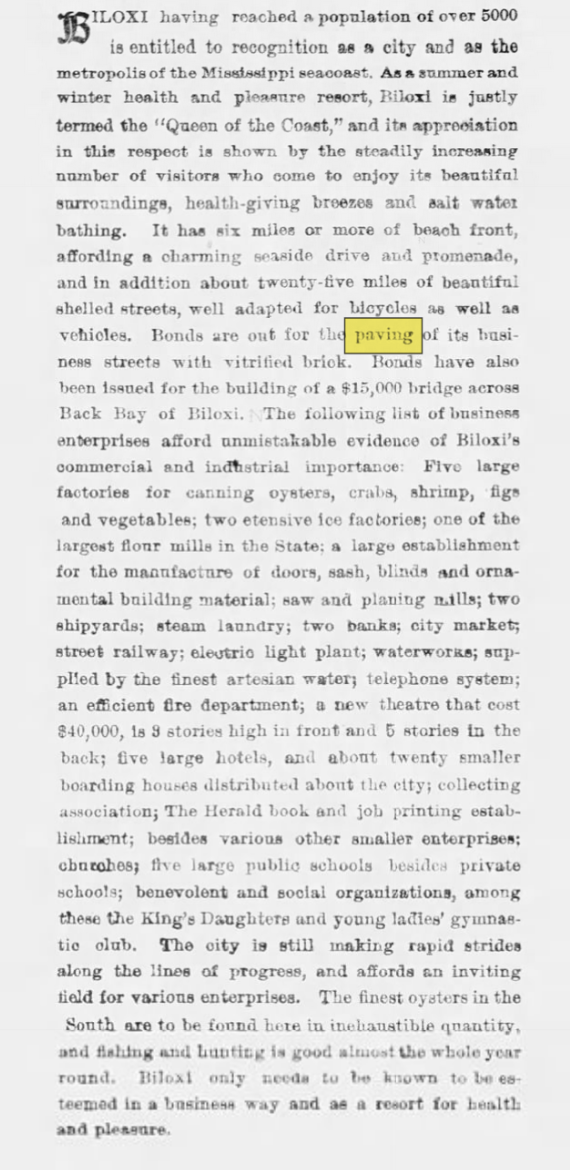
[The Biloxi Daily Herald, June 7, 1900, p. 5]